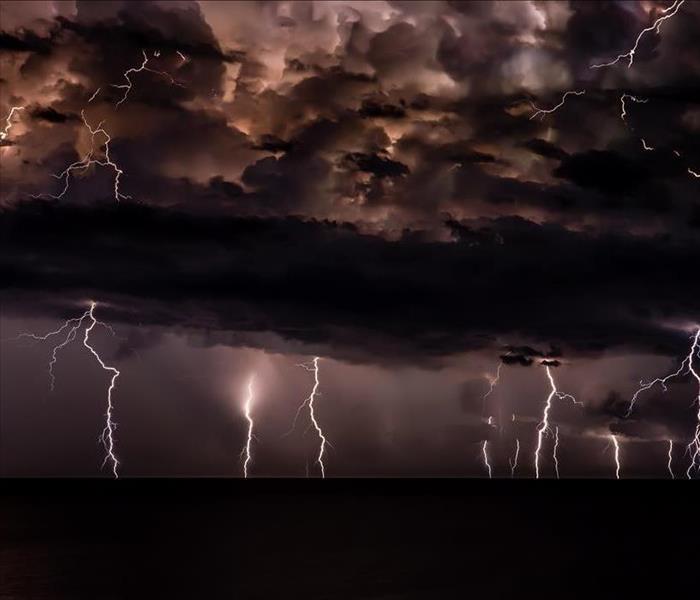Recent Storm Damage Posts
Frozen Pipes: Everything You Need to Know
1/7/2023 (Permalink)
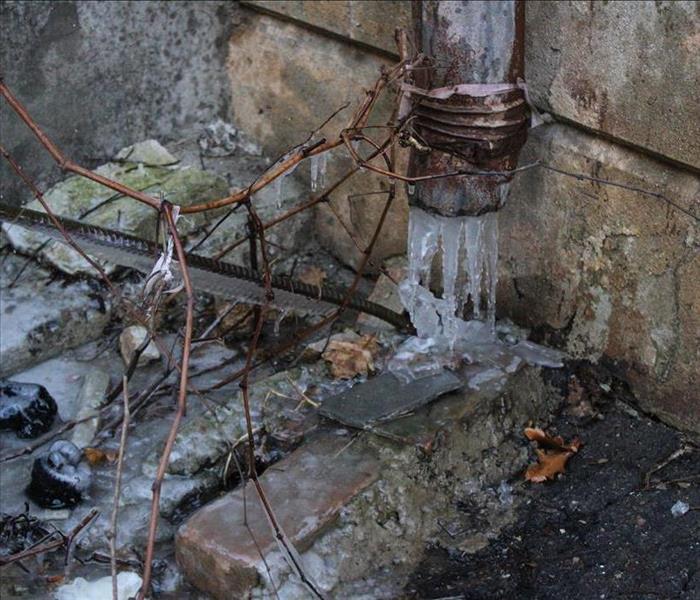 When the temperature drops below 20 degrees Fahrenheit, pipes can freeze.
When the temperature drops below 20 degrees Fahrenheit, pipes can freeze.
Winter weather is as pretty as it comes but, for commercial businesses, it can pose some serious property damage risks. No matter the scope of the damage caused by winter weather, SERVPRO Team Wall is standing by with the resources, experience, and expert knowledge to remediate your commercial property and prevent further damage. In this blog, we will discuss a common cold weather issue for commercial properties, frozen pipes, and ways in which you can protect your property from any storm damage that might result from frozen pipes.
Prime Conditions
When the temperature drops below 20 degrees Fahrenheit, pipes can freeze. It is only with proper insulation that pipes located outdoors or in unheated areas of your business can be at increased risk of bursting. Indoors, pipes in basements and crawl spaces are at the highest risk of freezing. During cold snaps, it is important to watch for frost, a lack of water coming from your faucet, and other signs of frozen pipes.
Preventing Frozen Pipes
The American Red Cross offers a few different suggestions to prevent pipes from freezing during cold periods. First and foremost, they assert that it is important to let water drip through your faucets. For pipes in unheated areas, consider adding insulation, which will help keep the pipes at higher temperatures than the rest of the room. It may also help to keep your nighttime thermostat temperature the same as your daytime temperature. Even though this hikes your heating costs, it will be worth it in the long run if it can help keep your pipes warm enough to protect against freezing and bursting.
Dealing With Frozen or Burst Pipes? Call SERVPRO Team Wall
If your commercial property’s pipes freeze and burst, SERVPRO Team Wall is here to help with our cutting-edge restoration equipment, as well as our expertise in storm and water damage restoration. Read more about our commercial storm and water damage restoration capabilities on our website. At first notice of burst pipes, call your local SERVPRO Team Wall office, SERVPRO of Hunt Valley and Harford County, at (410) 229-0012 right away to make it “Like it never even happened.”
Florida and Hurricane Season 2022
11/20/2022 (Permalink)
 Hurricanes – and strong storms in general – can impact your area at any time during hurricane season, even as late as November.
Hurricanes – and strong storms in general – can impact your area at any time during hurricane season, even as late as November.
Towards the end of year’s Atlantic hurricane season, Florida received the bulk of the action. As we’ve seen in the news, Hurricane Ian and Hurricane Nicole left their mark on Florida communities. SERVPRO Team Wall had the opportunity to serve affected communities in Florida, made possible by our Disaster Recovery Team. Making landfall in Florida within a relatively short time of each other, Hurricane Ian and Hurricane Nicole wreaked havoc on residential and commercial properties alike. Keep reading to learn more about where Florida’s 2022 hurricanes fit in the grand scheme of the Atlantic hurricane season.
Florida 2022 Hurricanes
Hurricane Ian, after making landfall in Southwest Florida in mid-September, caused significant damage, left many without power, and resulted in a devastating number of casualties. Just 43 days later, Florida was hit with yet another hurricane, Hurricane Nicole, once again caused power issues and sent first responders on search and rescue missions. This double-whammy may seem to be an anomaly, but something very similar happened in 2004. Hurricanes Charley and Jeanne, which both made landfall in Florida in 2004, affected nearly the same areas of the state as Ian and Nicole with the same amount of time in between the two storms. But what does this mean for property owners in Florida and across the country?
Call SERVPRO with Any Storm Emergency
Hurricanes – and strong storms in general – can impact your area at any time during hurricane season, even as late as November, which we see in the case of Hurricane Nicole. A November hurricane isn’t a rare occurrence; it is a very real possibility, especially for coastal states like Florida. For any emergency, call SERVPRO of Hunt Valley and Harford County at (410) 229-0012 for professional Storm Damage Restoration services. For commercial businesses, we also offer storm damage restoration services tailored to commercial properties. On our website, you can also learn more about our Large Loss Disaster Recovery Team and our other storm-related offerings like residential and commercial Water Damage Restoration services. Let SERVPRO Team Wall make it “Like it never even happened” after any emergency.
Storm Safety: Lightning 101
9/23/2022 (Permalink)
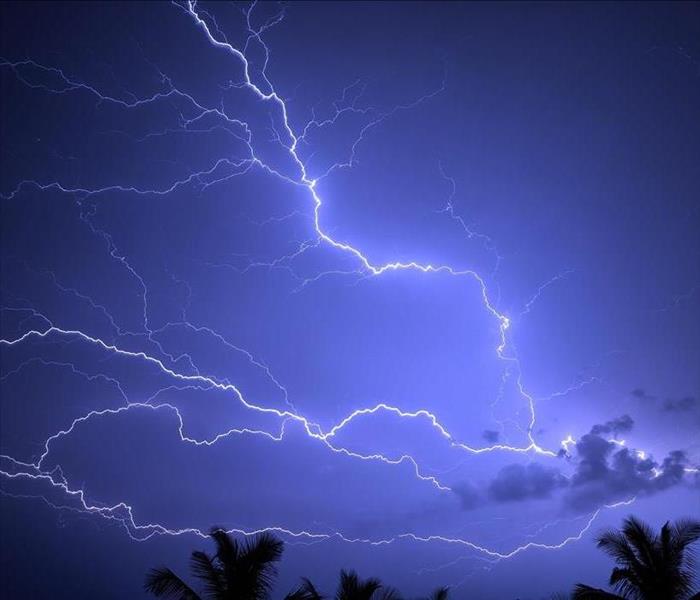 An important part of storm safety is understanding different types of lightning that you may see in a thunderstorm.
An important part of storm safety is understanding different types of lightning that you may see in a thunderstorm.
With almost any storm event, lightning is a serious human safety concern, but it also poses risks to residential and commercial properties. Even hurricanes sometimes produce lightning near the eye of the storm. An important part of storm safety is understanding different types of lightning that you may see in a thunderstorm. In today’s blog, informed by NOAA’s “Lightning Types” article, we’ll describe 3 different kinds of lightning and the property safety risks associated with them so that you can best protect yourself, as well as your home or business.
Cloud-to-Ground Lightning
The type of lightning with which the majority of people are familiar is cloud-to-ground lighting, which means that a channel of negative charge descends from a storm cloud and is met with a positive charge from tall objects nearby, which can include trees and power lines but- most important with regards to our topic today- tall structures like homes, office buildings, and other commercial buildings as well. The unification of the negative and positive charges causes an electrical current to flow. If the catalyst of the positive charge is a home or commercial property, the electrical current generated can pose safety risks to the property and people inside of it, as it can impact the electrical system and ignite fires. One way to prevent extensive damage from a lightning strike is equipping your property with surge protectors. Additionally, if you know that there is lightning in the area, stay away from electrical appliances and refrain from activities involving water, like taking a shower or washing dishes.
Cloud Flashes
Sometimes, lightning does not reach the ground. Cloud flashes describe lightning that usually remains in the clouds through what NOAA calls “intra-cloud lightning flashes.” This type of lightning is caused by “an electrical discharge between oppositely charged areas within the thunderstorm cloud,” according to The National Weather Service. While cloud-to-ground lightning may be the most dangerous type of lightning, if you see cloud flashes, a safety risk is still present. Cloud flashes still indicate that the storm is producing lightning, which means that there is risk of cloud-to-ground lightning developing.
Heat Lightning
You are probably familiar with the term “heat lightning,” but there is actually no such thing as heat lightning. According to The National Weather Service, if you see cloud flashes without thunder, what you are seeing is faint lightning flashes from a thunderstorm far enough away that you can’t hear the thunder or see the cloud-to-ground lightning generated by it.
Experience Lightning Damage? Call SERVPRO
If your residential or commercial business experiences lightning damage during a storm, call SERVPRO Team Wall. Our professional, experienced storm damage restoration specialists are equipped with the tools that will help make your property’s lighting damage “like it never even happened” after a storm. Call SERVPRO of Hunt Valley and Harford County at (410) 229-0012 to get in touch with one of our team members or visit our website to learn more about our Storm Damage Restoration capabilities, such as storm restoration services tailored specifically to commercial properties, our Disaster Recovery Team for large losses, and our water restoration process. To find peace of mind after any storm emergency and restore your property to its preloss condition, call SERVPRO Team Wall today.
Why Is September Peak Hurricane Season?
9/16/2022 (Permalink)
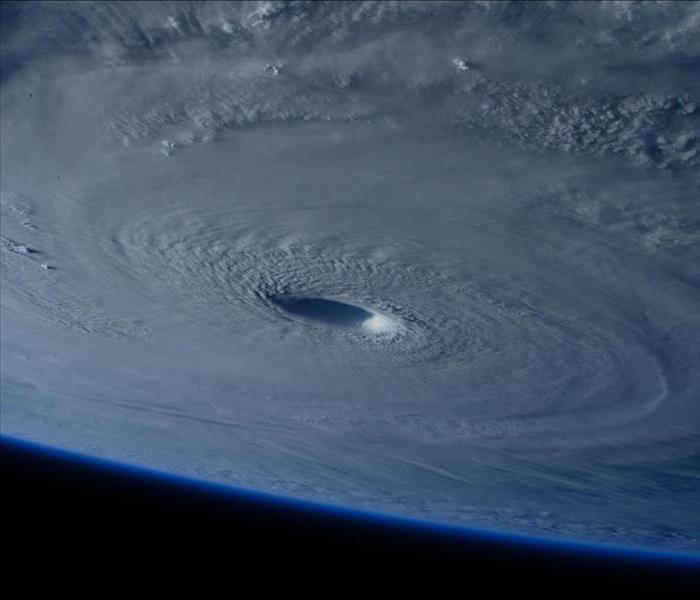 Property owners should continue preparedness efforts for storm activity, even as we enter the latter portion of hurricane season.
Property owners should continue preparedness efforts for storm activity, even as we enter the latter portion of hurricane season.
Just last week, weather.com posted an article referring to September as the “annual peak of Atlantic hurricane season.” According to the author, a senior meteorologist at weather.com, September 10th marked the statistical, climatological peak of hurricane season, which is “when the Atlantic Basin has had the most hurricanes and named storms over the course of history.” We know that hurricane season in the northern hemisphere lasts from June 1st through November 30th, according to NOAA. September 10th does not fall exactly in the middle of hurricane season, so what makes September peak hurricane season? Additionally, this blog will also explore the options property owners have when protecting their homes and businesses during peak hurricane season.
What Makes September Peak Hurricane Season?
The weather.com article points to several factors that increase the likelihood of hurricanes forming in the Atlantic during September, including “ocean water reaching its highest temperature, the atmosphere's ability to generate thunderstorms hitting its peak, and hostile shearing winds declining to a minimum,” as well as “tropical waves,” which peak in July and carry into September. Additionally, the author includes statistical data that illustrates the peak of hurricanes on or around September 10th, as well as 77% of named storms and 87% of hurricanes in an average hurricane season occurring in August, September, and October. From this information, it is clear that, while we are currently in the most active portion of hurricane season, hurricane prevalence stretches well into the next month. This means that residential and commercial property owners should continue preparedness efforts for storm activity, even as we enter the latter portion of hurricane season.
Hurricane Preparedness
The American Red Cross recommends that property owners prepare for two things before a hurricane: wind and flooding. To prepare for damaging winds caused by hurricanes, consider cutting back trees and bushes close to the property and secure windows with storm shutters. The best way to prepare for intense flooding is making sure that your gutters and drains are clear before the storm. Hurricanes, however, are a powerful force of nature and can cause unexpected property damage despite preventative measures. In the event that your residential or commercial property experiences storm damage in the aftermath of a hurricane, know that SERVPRO Team Wall is just a call away. At the first sight of damage, call SERVPRO of Hunt Valley and Harford County at (410) 229-0012 or visit our website to learn more about our professional Storm Damage Restoration services, Commercial Storm Damage Restoration, and our experienced Disaster Recovery/Large Loss Team. Trust SERVPRO to make it “Like it never even happened” after any emergency, large or small.
Where Are The Hurricanes?
8/4/2022 (Permalink)
 Property owners should still have hurricane preparedness in the back of their minds through the official end of hurricane season.
Property owners should still have hurricane preparedness in the back of their minds through the official end of hurricane season.
If you remember way back in June, at the beginning of summer, hurricane season had just begun for the Atlantic Ocean in the Northern Hemisphere. You may be wondering: where have the hurricanes been? This week, The Washington Post reported that this is the first year since 2017 that the Atlantic Ocean hasn’t seen a hurricane develop prior to August 1st. Back in June, NOAA forecasted an abnormally active hurricane season. So, should property owners still be preparing for hurricane season or should they throw in the towel?
There Is Still Time
Although we are beginning the third month of hurricane season, August and September are the peak of hurricane season. This means that, even though there hasn’t been much hurricane activity this year aside from a few tropical storms, there is still time and a risk that hurricane activity will increase. This means that property owners should still have hurricane preparedness in the back of their minds through the end of November, the official end of hurricane season.
Hurricane Preparedness Tips
Because there remains a threat for hurricanes this year, we would like to share two of our favorite proactive storm tips that can help protect your property in the event of a hurricane, flood, or even just a passing afternoon thunderstorm:
- Take a peek at your roof and gutters when the weather is nice. Oftentimes, these elements of a property are overlooked because they are not something we see on an everyday basis. Put simply: they’re out of sight, out of mind. When it is safe to do so, inspect your roof for things like missing or loose shingles and clogged gutters, as these things can put your property at risk for additional damage when a storm rolls through your area. It is critical to unclog your gutters and ensure that your roof is in good condition prior to a storm.
- Assemble a hurricane preparedness kit. Having a hurricane prep kit is a great way to ensure that those occupying your property have what they need in an emergency situation. Ready.gov offers a guide for putting together a hurricane prep kit, complete with items for families and offices, as well as personal items that may be beneficial to pack in your prep kit.
There is no way to predict how a hurricane- or any strong storm for that matter- will affect your home or business. However, you can always rely on SERVPRO Team Wall to be there for you no matter what happens. Our team and crews of storm damage restoration professionals are ready for anything, 24/7. Count on our trusted residential and commercial storm damage restoration services to make it “Like it never even happened” for your property. You can also read more about our water restoration process, as well as the ways in which we care for your belongings after a storm disaster, on our website. Call us today at (410) 229-0012 to learn more about what we can do for you.
Residential Lightning Hazards
6/17/2022 (Permalink)
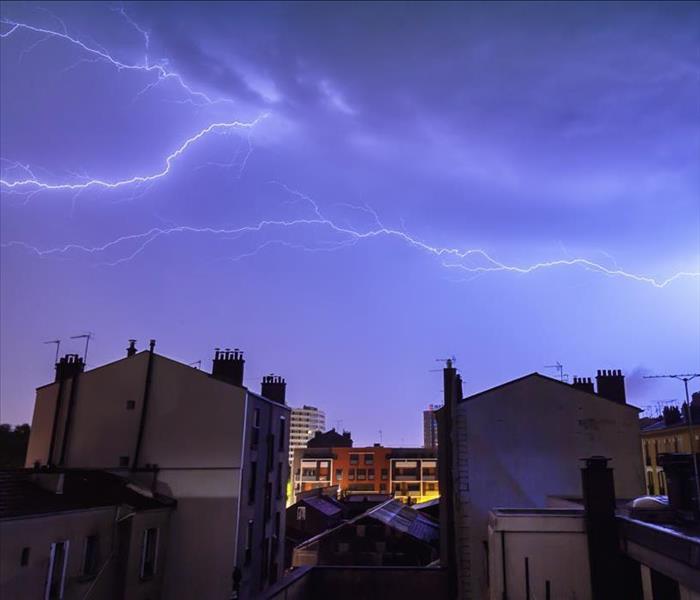 Indoor lightning safety is just as important as outdoor lightning safety.
Indoor lightning safety is just as important as outdoor lightning safety.
Did you know that almost one-third of injuries sustained from lightning strikes occur indoors, as assessed by The Centers for Disease Control? You may be familiar with lightning safety when outdoors, such as the necessity to get out of the pool at the first rumble of thunder. However, indoor lightning safety is just as important. While lightning is dangerous any time of the year, lightning occurs most frequently during the summer, which means that now is the time to become acquainted with indoor lightning safety in order to protect your home and those living in it.
Lightning- if it strikes a residential structure- can be a serious fire hazard. According to Weather.gov, “each spark of lightning can reach over five miles in length, soar to temperatures of approximately 50,000 degrees Fahrenheit, and contain 100 million electrical volts.” All this considered, lightning is powerful enough to ignite detrimental fires in residential structures and the electrical currents sent through homes as a result of lightning can pose significant safety risks to those living in the home. In the next portion of this blog, we’ll share some helpful indoor lightning safety tips.
Keep Your Distance from Electrical Equipment
We’ve learned that lightning can contain 100 million electrical volts, so it is imperative that you refrain from using electrical equipment during thunderstorms in order to prevent electrical shock or fire. Because lightning can travel through electrical currents, like those employed by radios and televisions, it is crucial to refrain from using devices that involve such equipment, like a corded landline. Instead, stay informed using a battery-powered radio or your smartphone. It can also be helpful to purchase surge protectors to protect your electrical appliances in the event of powerful storms.
Avoid Plumbing and Water
Just as it is important to get out of the pool or the ocean during a thunderstorm when outdoors, avoiding water and plumbing indoors is recommended. Lightning can travel through a property’s plumbing, which makes showering, taking a bath, washing the dishes, and other activities utilizing water dangerous during a thunderstorm.
Shelter in the Safest Area Possible
Lastly, be sure to seek shelter in the safest area of your home. In order to do this, do not seek shelter on porches. Instead, move to an interior room of the home and keep your distance from windows and doors. It may also come as a surprise that it is recommended to stay away from concrete floors and walls, as lightning can travel through concrete walls and flooring.
Storm Damage Takes You By Surprise? Call SERVPRO
Taking the precautions mentioned in this blog can help protect your home and those living in it, but storms are unpredictable and powerful. If your home experiences storm damage, SERVPRO Team Wall can help. You can read more about our reputable Storm Damage Restoration services and the SERVPRO Disaster Recovery Team on our website or call us at (410) 229-0012 to speak with one of our knowledgeable team members. Let us help you make it “Like it never even happened” after any disaster, large or small.
Summer Thunderstorms: Knowing What to Expect
6/3/2022 (Permalink)
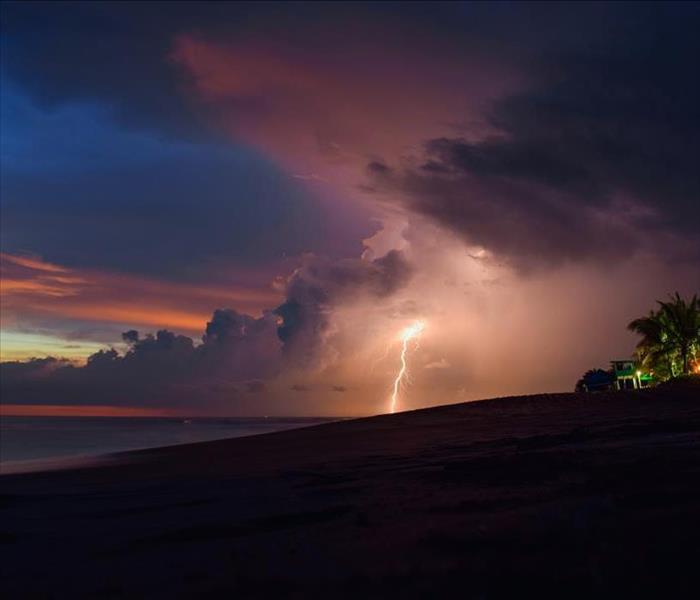 Did you know that there are multiple types of thunderstorms that vary in severity?
Did you know that there are multiple types of thunderstorms that vary in severity?
During the summer months, there is an increased risk of thunderstorms. Did you know that there are multiple types of thunderstorms that vary in severity? In this blog, utilizing information compiled by NOAA's National Severe Storm Laboratory, we’ll talk about what you can expect with each of these different kinds of thunderstorms. Keep reading to learn how SERVPRO Disaster Recovery Team - Team Wall can help in the event that a summer thunderstorm results in storm damage.
Single-Cell Thunderstorm
Especially on a hot summer afternoon, single cell thunderstorms are not unusual. This type of thunderstorm is typically short and weak, ending within an hour. While they may be brief, single cell thunderstorms often feature heavy rain, as well as occasional lightning.
Multi-Cell Thunderstorms
In comparison to single cell thunderstorms, multi-cell thunderstorms can last an hour to many hours. They are also stronger in nature, producing heavier rain that can lead to flooding, in addition to strong winds, tornadoes, and hail.
Squall Line
As opposed to single and multi-cell thunderstorms, a squall line is a group of consecutive storms, forming a line. It is typical of squall lines to produce high winds and heavy rain. While they appear stronger, like multi-cell thunderstorms, they usually pass over an area quickly and are less likely to produce tornadoes. Sometimes, there can be super squalls, which can last closer to an hour.
Derecho
A derecho is a very rare weather event that is characterized by a lengthy storm with strong winds, alongside rain showers and thunderstorms that move rapidly. Often, derechos can cause destruction comparable to that of a tornado. However, property owners can take comfort in the fact that derechos occur at a very infrequent rate.
Have Storm Damage? SERVPRO Can Help
In the event that your home or business endures storm damage this summer as a result of one of the types of storms described above, or any kind of storm, SERVPRO Disaster Recovery Team - Team Wall is here to help. Our highly-trained storm damage restoration technicians are standing by with the skills and advanced technology necessary to provide customers with top-quality Storm Damage Restoration services. Additionally, our SERVPRO of Hunt Valley and Harford County website is teeming with resources, such as our Water and Storm Damage Tips page, which can help prevent additional damage before help arrives. You can also find peace of mind in knowing that SERVPRO Team Wall is part of the larger Disaster Recovery Team, composed of SERVPRO teams across the country, a tool that allows us to compile resources and put our heads together in the event of disastrous storm events. Call SERVPRO of Hunt Valley and Harford County right away at (410) 229-0012 to make it “Like it never even happened” for your residential or commercial property.
Preparing Your Home for Thunderstorms
3/17/2022 (Permalink)
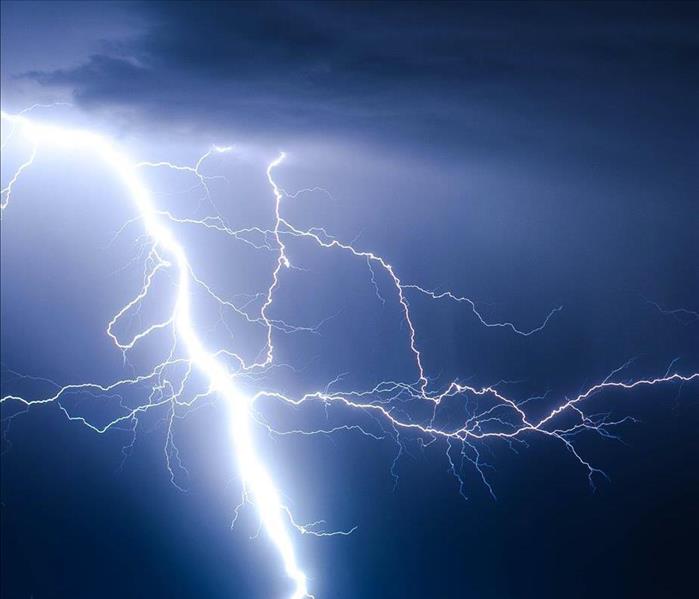 At their worst, thunderstorms can produce lightning, high winds, intense bursts of rain, and hail, leading to downed trees and powerlines.
At their worst, thunderstorms can produce lightning, high winds, intense bursts of rain, and hail, leading to downed trees and powerlines.
Thunderstorms are a type of storm that we tend to downplay in terms of its severity, as they often come and go, some largely harmless and others leaving a long path of destruction. At their worst, thunderstorms can produce high winds, intense bursts of rain, and hail, leading to downed trees and powerlines, as well as flash flooding. According to the American Red Cross, lightning produced from thunderstorms causes more deaths than hurricanes and tornadoes. Therefore, it is important to prepare your home for the worst when it comes to thunderstorms. In this blog, we’ll explore a few ways in which you can protect your home from thunderstorm damage.
3 Thunderstorm Safety Tips
The American Red Cross has published lists of tips for thunderstorm safety before, during, and after a thunderstorm. For the purposes of this blog, we would like to spotlight thunderstorm safety tips that are specifically designed to prevent storm damage to your home. The first tip is to have a list of things to bring inside before a thunderstorm. For example, if you have anything large or heavy outside that can potentially be transported inside, it may be beneficial to do so, as large objects can be picked up by the wind and inflict damage upon your home. Next, it may be helpful to double-check that your homes’ doors and windows are completely and securely shut. When it comes to windows, installing shutters may provide additional support, as they can prevent windows from breaking. Lastly, we mentioned earlier that thunderstorms can lead to downed trees, which makes it imperative that trees and other types of shrubbery are trimmed as best as possible in order to decrease the chances of branches flying from trees.
Call SERVPRO for Expert Storm Damage Restoration
At the end of the day, you can follow through with the actions suggested above, but weather is often unpredictable. One aspect that is predictable and reliable, however, is that SERVPRO Disaster Recovery Team – Team Wall is always standing by and ready to help. No matter the size of your emergency and regardless of where it takes place, our team of storm damage experts provide 24-Hour Emergency services so that we can serve our customers as soon as possible. Trust our Storm Damage Restoration services to restore your home to its preloss condition, making it “Like it never even happened.” Check out the rest of our website and, specifically, our Commercial Storm Damage services overview and SERVPRO Disaster Recovery Team pages.
Storm Safety: Thundersnow
1/7/2022 (Permalink)
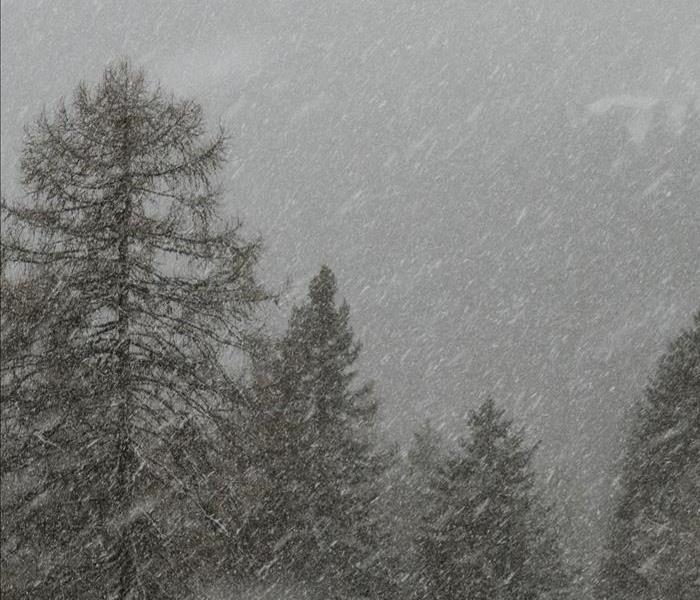 Thundersnow, a bizarre combination of thunder, lightning, and snow, happens every now and then.
Thundersnow, a bizarre combination of thunder, lightning, and snow, happens every now and then.
We have all experienced a thunderstorm or two in our time, but have you ever witnessed “thundersnow?” There’s a good chance that you’ve never heard of thundersnow, as it is a rare winter weather occurrence, but this bizarre combination of thunder, lightning, and snow happens every now and then. As a matter of fact, thundersnow has already made its first appearance in Maryland in 2022. Keep reading to learn more about thundersnow and the ways in which it can affect your home or business this winter.
What Is Thundersnow?
Thundersnow is essentially a thunderstorm with precipitation in the form of snow instead of rain. According to the Farmer’s Almanac, thundersnow, like thunderstorms, occurs when warm and cool air meet in the atmosphere. It is uncommon for this kind of clash in the atmosphere to take place during the winter, but it is possible. On the East Coast, we may see thundersnow when a cold front, like a Nor’easter, arrives quickly after a warmer cold front.
Thundersnow Safety
It is important to remember that thundersnow still contains lightning, which can be dangerous. In addition to threatening all of the safety risks of a thunderstorm, thundersnow also imposes the dangers of a snowstorm, which creates increased, multifaceted safety concerns for homes and businesses. During a thundersnow event, your home or business will be subjected to rapid snowfall, as well as the strong winds and lightning strikes, both characteristics of traditional thunderstorms. Therefore, in order to stay safe during a thundersnow event, be sure to stay indoors and have a plan in the event of a power outage. The unexpected factor of thundersnow events adds yet another safety risk, as they can catch you by surprise. Be sure to listen for thunder and keep an eye on the sky for any signs of lightning if you are out during a snowstorm.
Trust SERVPRO’s Storm Damage Restoration Services
While thundersnow events are uncommon, snowstorms and other cold weather events, such as freezing rain and severe snowstorms like blizzards, occur somewhat more frequently during the winter months. Regardless of what this winter season has in store, know that SERVPRO Disaster Recovery Team - Team Wall provides the Storm Damage Restoration services that will help return your home or commercial business to normal after any weather event. If your property experiences storm damage this winter, acquire the help of our Disaster Recovery Team and receive immediate attention with our fast, 24 Hour Emergency Service by calling your local SERVPRO Team Wall office, SERVPRO of Hunt Valley and Harford County, at (410) 229-0012 right away. Don’t wait. Make it “Like it never even happened,” by calling SERVPRO of Hunt Valley and Harford County today.
What Are Snow Squalls?
11/12/2021 (Permalink)
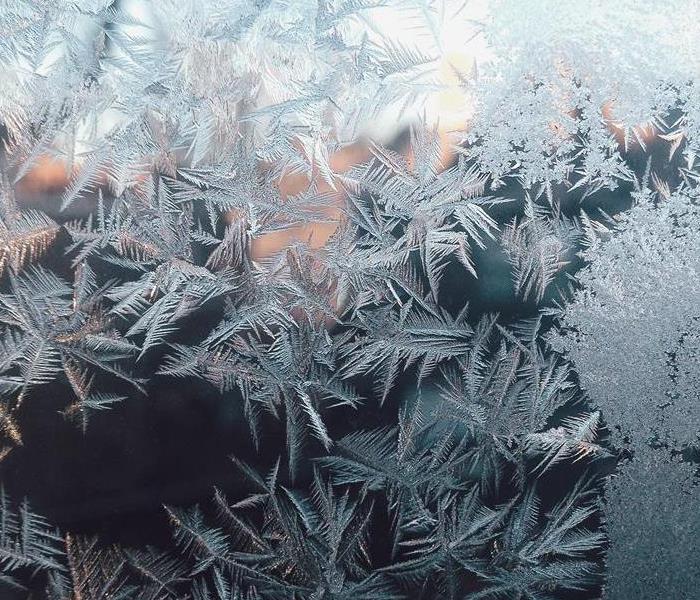 In the aftermath of a snow squall, SERVPRO Disaster Recovery Team - Team Wall is here to help.
In the aftermath of a snow squall, SERVPRO Disaster Recovery Team - Team Wall is here to help.
It seems as though every winter, we hear this term “snow squall” tossed around in weather reports and conversation. But how many of us know what exactly a snow squall is? More importantly, how can snow squalls impact your safety this winter?
What Is a Snow Squall?
According to the National Weather Service, a snow squall is an “intense short-lived burst of heavy snowfall,” lasting up to about 30 minutes. They can quickly lead to sudden reductions in visibility on the road and they are often accompanied by gusty winds. Additionally, areas may experience either just one snow squall or multiple, consecutive snow squalls. They can happen at any time of day, so it is important to keep in mind that if a snow squall occurs at night, visibility can be even more obstructed due to waning daylight. Rest assured, snow squalls are not everyday events during the winter months. In fact, they are extremely rare. Therefore, we can think of snow squalls as the wintertime equivalent of severe thunderstorms.
Hazardous Driving Conditions
During a snow squall, the amount of snow that falls to the ground is minimal, but the intensity of the snow event can create numerous hazards for those on the road. For example, freezing road surfaces can cause pile-ups and major accidents on roadways when vehicles slip. With snow squalls, whiteout, blizzard-like conditions tend to seemingly appear out of nowhere. In a sense, snow squalls are mini-blizzards, possessing the same level of intensity as blizzards but condensed into a significantly shorter time frame.
Staying Safe During a Snow Squall
There are several steps that you can take in order to stay as safe as possible during a snow squall. Be sure to listen to the radio and keep up with forecasts when you’re planning to be on the road. If you must drive when there is a forecasted risk for a snow squall, get off of the road at the first sign that conditions are becoming dangerous. It is helpful to slow down in hazardous conditions, just as you would in any other snow storm. It is also beneficial to keep your headlights on and avoid slamming on the brakes when roads are slick in order to avoid accidents.
SERVPRO Offers Professional Storm Damage Restoration Services
In the aftermath of a snow squall, SERVPRO Disaster Recovery Team - Team Wall is here to help. Our team of storm damage professionals offers both commercial and residential winter storm damage services. Call SERVPRO of Hunt Valley and Harford County right away at (410) 229-0012 after any kind of storm damage this winter in order to make it “Like it never even happened.”
Generator Safety During Storms
9/30/2021 (Permalink)
 How many of us feel confident that we have a sufficient grasp on generator safety?
How many of us feel confident that we have a sufficient grasp on generator safety?
How many times has a generator restored a sense of normalcy to your life during or in the aftermath of a storm? Providing us with light, cold air in our refrigerators, the ability to charge our phones, and so much more, generators can be a lifesaver. The hope is that we don’t have to use our generators often, but as a result, how many of us feel confident that we have a sufficient grasp on generator safety? According to Consumer Reports, generators can pose safety risks, such as carbon monoxide poisoning and fire hazards, to residential and commercial properties alike, as well as those living or working in them. Here are our top generator safety tips to keep in mind during or after a storm.
- Keep Your Generator Outside
Storing your generator indoors, in a garage, or any enclosed space increases the risk of carbon monoxide poisoning. The American Red Cross recommends that generators should be kept away from windows and doors in order to further prevent carbon monoxide from entering your home or business. Out of an abundance of caution, it is also beneficial to install a carbon monoxide detector and alarm system in your residential or commercial property. These devices will alert anyone inside of the home or building of carbon monoxide so that they can exit the property immediately.
- Store Fuel in a Safe Location
Generators require fuel in order to power your home and in the event of a storm that may cut off your power for multiple days on end, you will likely need to stock up on extra fuel. When storing fuel, it is important to keep it in a cool space that is well-ventilated and outside of any living spaces. Generator fuel is a serious fire hazard, so it is critical that fuel is stored properly in a location protected from any items that may ignite fire.
- Consider Installing a Transfer Switch
The fire hazards associated with extension cords can be avoided with the help of a transfer switch, which connects your generator directly to your property’s circuit panel. It is dangerous to plug your generator into a wall outlet. This practice is also known as “backfeeding” and can increase the risk of electrocution. Transfer switches eliminate the need for engaging in this dangerous activity and can also prevent overloading, as they sometimes display wattage use levels.
SERVPRO Is Standing By
If you decide to utilize a generator to power your home or business after a storm leaves your property without power, be sure to exercise caution. Serious safety hazards, as well as significant risks to your property, accompany generator usage. Therefore, it is important to have an emergency plan in the event that generator usage leads to fire damage to your property. Our team of fire damage restoration experts will respond immediately when you are in need. Call SERVPRO of Hunt Valley and Harford County right away at (410) 229-0012 if your home or business experiences fire damage resulting from generator usage. Visit our website for an overview of our Storm Damage Restoration, Fire Damage Restoration, and Commercial Fire Damage Restoration services. We are standing by, ready to make it “Like it never even happened.”
Professional Commercial Storm Response With SERVPRO This Hurricane Season
9/23/2021 (Permalink)
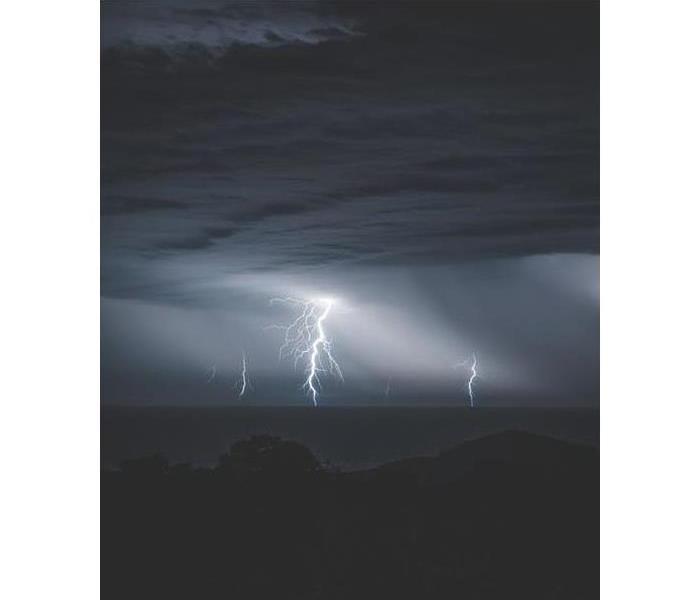 Now is the perfect time to step back and consider your commercial business’ hurricane emergency plan.
Now is the perfect time to step back and consider your commercial business’ hurricane emergency plan.
Hurricane season 2021 has been in full swing since June, but we often see storms during the autumn season, as hurricane season extends into late November. Therefore, now is the perfect time to step back and consider your commercial business’ hurricane emergency plan. If disaster strikes and your commercial property experiences storm damage, do you have a plan? Calling SERVPRO is a great first step. We will be there for you from the beginning to the end of the job, handling both the mitigation work and reconstruction work that needs to be completed in order to get your business back on schedule.
We Are Reconstruction Professionals
Many people know us as mitigation experts, but we are also reconstruction professionals and offer a long list of building services such as drywall installation, floor repair, and roofing services. When you call us after any storm damage emergency this hurricane season, we will work to mitigate storm damage or water damage, remove water, complete demolition work, and finally, provide rebuild services that will get your commercial property back to its preloss condition. Our mission is to make it “like it never even happened.” Wondering what these services look like in real life? We’ll walk you through a few of our standout commercial storm damage restoration projects in the last year:
The Phoenix Buildings
Orange Beach, Alabama was hit hard during the relentless 2020 Hurricane Season. Our team traveled to Orange Beach in order to help mitigate water damage and restore two condominium buildings that had been impacted by Hurricane Sally, water damage affected multiple stories of condos from the top to the bottom of the buildings. Our success at the Phoenix Buildings emphasizes our capability to handle everything from water damage restoration services to reconstruction services and be a “one-stop-shop” for our customers. Read more about our experience working at the Phoenix Buildings here.
Immaculate Conception Catholic School Winter Storm Damage
Our work doesn’t stop with hurricane season. Our Disaster Recovery Team and commercial storm damage experts also take on storm damage resulting from severe winter storms. This February, we traveled to the Immaculate Conception Catholic School in Denton, Texas after winter storm Uri, which caused burst pipes and extensive water damage. Not only did the school require storm damage restoration, but it needed reconstruction services like drywall installation and floor replacement as well, which we were able to complete. For more information about our work at the ICCS, check out our blog post.
We Can Do It All
We handle every step of the job until your commercial property is completely restored to its condition before the storm’s arrival in your neighborhood. Storm damage interrupts the crucial, everyday operations of your company. We save you time and money by offering both professional storm damage restoration and reconstruction services. Because our team is made up of mitigation and reconstruction professionals alike, you won’t have to spend time finding someone else to take over the second half of the job. In a letter of recommendation written by a recent client, they communicated:
“SERVPRO Disaster Recovery Team - Team Wall (SERVPRO Team Wall) was able to respond to our restoration and reconstruction needs at our affected facilities with an impressive response time… It is with confidence that I recommend SERVPRO Team Wall for any restoration and reconstruction services. I am certain the same level of quality, service, and responsiveness would be provided for all those enlisting their services.”
We get the job done quickly and will have your business back on its feet in no time. For more information about our Commercial Storm Damage Restoration services, our SERVPRO Disaster Recovery Team - Team Wall, and our 24-Hour Emergency Service, visit our website. You can read more about our experience with hurricane restoration in our latest Hurricane Preparation Tips blog. Call SERVPRO of Hunt Valley and Harford County today at (410) 229-0012. We are here for you no matter what this year’s hurricane season has in store.
Preventing Flood Damage to Your Property
9/16/2021 (Permalink)
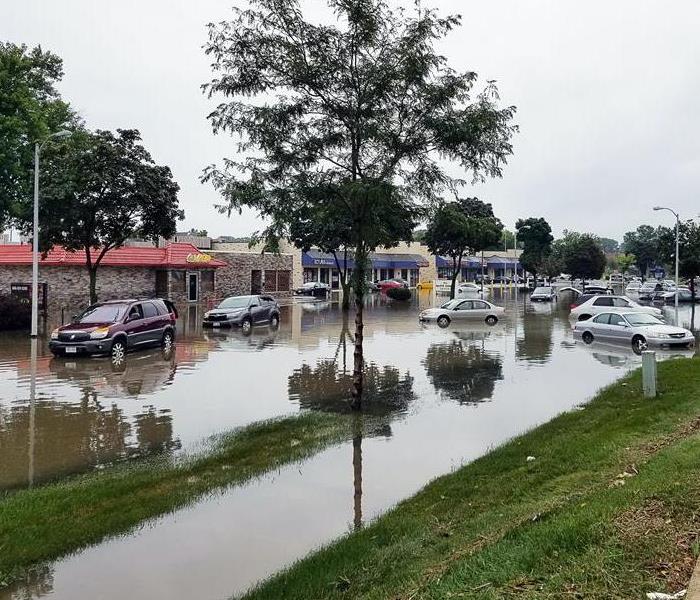 According to the Federal Emergency Management Association, “Flooding is the most common and costly disaster in the United States.”
According to the Federal Emergency Management Association, “Flooding is the most common and costly disaster in the United States.”
Flooding is a year-round concern, but hurricane season may increase the likelihood of severe storms that are capable of producing flooding. According to the Federal Emergency Management Association, “Flooding is the most common and costly disaster in the United States.” FEMA also recommends that homeowners take 3 important steps to minimize flood damage: “Know Your Risk”, “Insure Your Property”, and “Reduce Your Risk.” In this blog, we’ll discuss ways in which you can reduce your property’s risk for experiencing flood damage in accordance with FEMA’s guidelines.
Preventative Measures Inside and Outside
There is a wide array of indoor and outdoor preventative measures that you can take in order to best protect your home or business from flooding damage both well in advance or immediately before the storm hits. Outside, be sure that you clean out your gutters regularly, as doing so prevents them from becoming clogged and helps rainwater drain properly during a storm. Outdoor equipment and utilities, including heat pump or air conditioning units, can be elevated at least 1 foot off of the ground in order to decrease the potential for costly water damage during a flood. Inside, it may also be beneficial to elevate your indoor units, such as your HVAC system, in the event of indoor flood damage. Lastly, be sure to keep valuable indoor items, which may include important documents and sentimental objects, in watertight containers within a safe, elevated location. This step prevents such items from enduring irreversible water damage in the wake of a flood.
Call SERVPRO for Professional Storm Damage Restoration
Even with preventative measures in place, storm damage due to flooding is never 100% avoidable. However, taking the steps outlined in this blog and those recommended by Ready.gov can help minimize serious damage. That’s why SERVPRO of Hunt Valley and Harford County is standing by and always ready to help in the event that your home or business needs to be restored to its preloss condition after a damaging flood. Our website contains various flood and storm damage resources, including our Storm Damage Cleanup and Restoration, Commercial Storm Damage, and Water and Storm Damage Tips pages. Call us at (410) 229-0012 at the first sign of damage after a flood or severe storm for immediate, professional assistance and restoration services that you can trust.
Breaking Down Our Water Damage Restoration Process
9/9/2021 (Permalink)
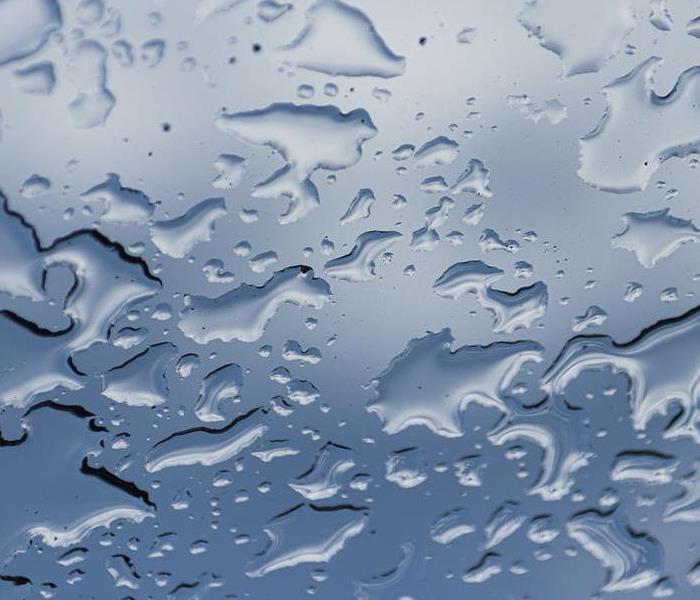 Consistency and professionalism are what our team of water damage experts displays on a daily basis.
Consistency and professionalism are what our team of water damage experts displays on a daily basis.
When your home or business experiences a water damage emergency, what can you expect from SERVPRO of Hunt Valley and Harford County? Consistency and professionalism are what our team of water damage experts displays on a daily basis, as they follow a specific water damage restoration process and series of steps to ensure that your property receives the fastest and most effective restoration services after any storm. In this blog, we’ll break down our Water Damage Restoration Process so that you can gain a deeper understanding of what to expect from our services after any water damage emergency.
Our 6-Step Water Restoration Process
The whole water damage restoration process begins with your call. Immediately, we ask preliminary questions so that we can be prepared to arrive onsite with the most helpful resources and equipment to get the job done.
- Inspection and Water Damage Assessment
Once our team arrives onsite, we work to assess the scope of your property’s water damage and determine the severity of the water damage based on industry standards set by the Institute of Inspection, Cleaning, and Restoration Certification. The final step before we begin removing the water involves examining how far the water has traveled throughout the property in order to ensure that we complete a comprehensive water damage restoration of all affected areas.
- Water Removal and Extraction
Using pumps and vacuums, our team works quickly to remove and extract the water. This step is crucial in order to prevent secondary water damage as well as the growth of mold and mildew.
- Drying and Dehumidification
In this stage of the water damage restoration process, we focus on removing the water that is more difficult to reach and was subsequently not able to be extracted in Step 3. We also take measurements of temperature and relative humidity in order to determine the number of dehumidifiers and air movers that will be necessary to remove this excess water and thoroughly dry your property.
Water damage can often leave items unsanitary, which is why Step 5 focuses on cleaning and sanitizing in addition to removing odors from your belongings that have been impacted by water damage. Various techniques are utilized to achieve these goals, including Dry Cleaning, Wet Cleaning, Spray and Wipe, Foam Cleaning, Abrasive Cleaning, and Immersion Cleaning.
Our final step is restoration, which is all about getting your property back to its preloss condition, making it “Like it never even happened.” Our team of professionals take care of everything from major repairs, such as rebuild and reconstruction services, to minor repairs, including the installation of new drywall or carpet replacement.
Here for You Throughout the Entire Process
Water damage emergencies resulting from storms in residential and commercial properties alike can be stressful and scary, which is why you need a team of water damage restoration specialists by your side. As soon as you call SERVPRO of Hunt Valley and Harford County at (410) 229-0012, our professionals will have your back throughout the entire restoration process until your property has been restored to its preloss condition. For more information about our Water Damage Restoration and Commercial Water Damage Restoration services, as well as additional Water Damage Tips, check out our website.
Summer Storms Spark Lightning Damage
6/8/2021 (Permalink)
Every summer brings its fair share of storms, ranging from light rain showers to severe squalls, risking damage to homes, commercial buildings, and other structures. In an effort to help homeowners and business owners navigate the increased risk of storm damage with summer storms, we dedicate one or two blogs to storm safety every summer. In the past, such blogs have dealt with hurricane preparation and flash flooding. However, it is important to also emphasize the hazards of lightning in addition to flooding, fallen trees, and other forms of storm damage. Lightning can spark fires, power surges, and even major structural damage when it directly strikes commercial buildings and homes. In order to gain a more comprehensive understanding of the damage that lightning can do in addition to what steps you should take in the event that your home or business is struck by lightning, keep reading.
Types of Lightning Damage
Fire damage is perhaps the most predictable type of damage that would result from a lightning strike. Attics and top floors of buildings, due to their proximity to the roof, are especially vulnerable to fire after a lightning strike. Traveling via electrical circuit and wires, fire can also ignite in other areas of a home or business. In terms of the structure of a building in the aftermath of a lightning strike, roofs and attics can be destroyed, scorched by the lightning. Personal belongings can also be placed in jeopardy when lightning strikes a building, which propels electrical surges throughout the building’s structure. As a result, electronic devices, such as computers, televisions, and appliances, can be damaged significantly or become destroyed.
I Think That Lightning Struck My Building- What Should I Do?
If you hear a loud crash that transcends the usual volume of a distant roll of thunder or lightning strike, it is possible that your home or business has experienced a direct lightning strike. The risk of experiencing a direct lightning strike is low, but it is essential to know what to do in the event that it happens in order to minimize damage to your home or business as best as possible. The first step is to check for fire. As soon as it is safe to go outside, look for damage to your roof and your home or business’ surroundings. Inside, you should also check electrical switches, breakers, and outlets for signs of damage, as well as piping for leaks, which can lead to flooding. In the event that you discover damage of any kind, call a professional immediately.
SERVPRO Is Here to Help
Here at SERVPRO of Hunt Valley and Harford County, we are a team of storm damage professionals who are ready to help your home or business recover after lightning damage or storm damage of any kind. By calling us right away at (410) 229-0012, you can ensure that our team will be onsite quickly, prepared to make it “Like it never even happened,” by providing reputable Storm Damage Cleanup and Restoration Services. To learn more about the specific storm damage remediation services that we offer, check out our pages dedicated to such topics as Commercial Storm Damage Restoration. After storm damage of any shape or size, we also offer various cleanup services to fit your home or business’ unique needs, including Building Services such as Roofing Services in addition to Fire Damage Restoration Services and Mold Remediation. We know that every storm is different, presenting distinct and individualized challenges for every home or business that it affects. That’s why our team here at SERVPRO of Hunt Valley and Harford County tailors our services to every customer, working as quickly as we can to get you back to business as usual.
Restoring Fort Sill: A Team Effort
5/19/2021 (Permalink)
Every so often, we’re granted the opportunity to combine the forces of our three SERVPRO Team Wall locations on a job in order to help our customers. In March, all three of our locations, alongside SERVPRO Team Bowen, took on our largest job ever, providing our services to Fort Sill, a historic military base in Oklahoma. After enduring around 200 pipe bursts in the wake of this winter’s deep freeze that hit Oklahoma and Texas, Fort Sill was in need of all the help they could get to restore the base to its preloss condition.
What Is Fort Sill?
The largest field artillery complex in the country, Fort Sill sits on 94,000 acres of land. Additionally, Fort Sill is a National Historic Landmark and over the years, it has hosted many troops, including the famous African-American “Buffalo Soldiers,” and today, Fort Sill is the site of the grave of Geronimo, a Chiricahua Apache religious and military leader. It is a U.S. Army base in addition to serving as a base for the Marine Corps, which meant that there were many people depending on our help to restore Fort Sill.
Combining Our Resources
The Fort Sill job was the largest project that SERVPRO Team Wall has ever faced, which makes our successful work all the more rewarding. We inspected about 110 buildings throughout the base using thermal imaging cameras and moisture meters in order to detect moisture and eventually went on to work in 50 of those buildings, all of which experienced at least one burst pipe. In order to meet Fort Sill’s needs, all three of Team Wall’s locations joined forces alongside SERVPRO Team Bowen. Eight crews supervised a total of 70 to 100 people on any given day, with supervising roles ranging from overseeing demolition and drying processes to monitoring equipment, which included small format equipment as well as four tractor trailers. These tractor trailers carried about 1,000 air movers and 200 dehumidifiers. Over the course of the 17 days that our crews were onsite at Fort Sill, we provided temporary power and climate control, descants, dehumidifiers, and ran generators in six different buildings simultaneously. Completing this job was no small feat, but SERVPRO Team Wall was able to restore Fort Sill to its pre-storm condition by combining the resources of each of our three locations.
Trust SERVPRO Team Wall’s 3 Locations for Your Storm Needs
While the Fort Sill job may appear larger than life, this is the reality of what SERVPRO Team Wall does on a daily basis, albeit at a smaller scale. Whenever a storm rolls through your area, whether it be a localized thunderstorm or a widespread storm, SERVPRO is standing by with the resources to handle any size emergency. You can learn more about our professional Storm and Flood Services, as well as our Water Restoration Process by checking out the Storm Damage page on our website. Remember that we also offer Mold Remediation and Restoration services, which may be needed if water damage leads to mold growth. For both storms and disasters alike, know that you can call SERVPRO of Hunt Valley and Harford County at (410) 229-0012 for storm damage restoration services and professional resources that you can trust.
Surviving the Polar Vortex
3/24/2021 (Permalink)
Every winter, the phrase “polar vortex” means suiting up in our warmest winter coats, hats, and gloves. The Polar Vortex refers to a zone of cold air that gravitates toward the Earth’s two poles, according to the National Weather Service. We experience the Polar Vortex when that air takes a trip south during the winter, bringing us our own slice of Arctic air. It creates almost unbearable, cold conditions for us, risking such conditions as hypothermia, but it may come as a surprise to know that our homes and businesses can suffer just the same. Just as we need our heavy coats and cozy scarves, our homes and businesses need protecting from the cold.
Our homes and businesses can fall victim to freezing pipes and ice dams, which can both lead to serious water damage, during the polar vortex of the winter. The freezing, Arctic temperatures characteristic of the polar vortex can cause the water inside of pipes to freeze and expand, resulting in burst pipes. On the roof, when snow and ice accumulate, ridges of ice can form and block melting snow from leaving the roof. As a result, the water may leak down into the roof. Keep reading for our checklist of actions that you can take to protect your home or business from the potential dangers presented by the polar vortex.
Our Polar Vortex Survival Guide
For Ice Dams
- Clean snow off of your roof as soon as possible. However, be sure that you wait until the snow has stopped or there is a break in the storm. Before a snowstorm, it is helpful to remove any lingering snow or ice from a previous storm from the roof.
- Be sure that your attic or top floor is properly insulated before a storm. If your amount of insulation is lacking, it may be beneficial to add extra insulation.
For Freezing Pipes
- Before a storm, be sure that all pipes are insulated and any cracks that they may have are sealed.
- When temperatures drop, let your faucets drip in order to keep water flowing, which prevents the water from freezing.
- Maintain consistent, warm temperatures inside of your home or business. Additionally, make certain that your insulation is sufficient throughout the home or building
Trust SERVPRO This Winter
It’s impossible to predict exactly what will come our way this year, but regardless of what this year has in store, look no further than SERVPRO. If your home or business experiences water damage as a result of the polar vortex or harsh winter weather in general, our team of storm and water damage specialists can be trusted to provide water mitigation services that will get things back to normal in no time.
Job of the Quarter: The Phoenix Buildings
1/18/2021 (Permalink)
Hurricanes are infamous for being forces to be reckoned with.
There’s a reason that the Scorpions produced a hit rock song with the title “Rock You Like A Hurricane” in 1984. Hurricanes tear through whichever unlucky towns sit in their path and leave behind colossal damage, resulting in millions of people unsure of how to get back on their feet.
This is Where SERVPRO Comes In
Racing across the country to help those in need. The 2020 hurricane season was relentless, with hurricanes that proved to be too much for even the English alphabet to handle, and it kept us on our toes with storm work. Each quarter, we select one job that particularly showcases our team’s strengths in its process and completion. This quarter, after such a busy hurricane season, our selection is the Phoenix Buildings, a job that required a trip all the way down to Orange Beach, Alabama in order to mitigate water damage in two condo buildings that had been seriously impacted by Hurricane Sally, which hit in September. What makes the Phoenix Buildings job worthy of our distinguished “Job of the Quarter” title is a combination of the teamwork that this large-scale job required, our impeccable turnaround time, and our ability to be our customers’ “one-stop shop”.
The first storm to make landfall in Alabama since 2004 with Hurricane Ivan, Hurricane Sally introduced itself as a powerful force and left a path of destruction in Orange Beach. When we received the call from Storm Team Wilson concerning a condo building that was in need of our storm restoration services, our team immediately headed down to Alabama in order to help those living in the building pick up the pieces. Initially, we were only tasked with work on one of the Phoenix Buildings, but after showcasing our ability to quickly and efficiently complete work on the first building, we were given the opportunity to provide our services to yet another one of the Phoenix Buildings, offering a helping hand to even more residents.
Because the Phoenix Buildings job involved work on multiple stories of condos, our team faced challenges in a variety of matters, from obtaining keys for specific units to completing work while residents were still living in them. Hurricane Sally brought driving rain that seeped into the condo units through sliding glass doors, resulting in water damage from the top to the bottom of each building. Our customers were in need of a speedy restoration that would get their lives back to normal after a devastating weather event and its ramifications- things that were all completely out of their control.
Teamwork Makes The Dream Work
Restoring the condos as quickly as we did required all three of SERVPRO Disaster Recovery Team Team Wall’s offices to band together. We completed work on both buildings within two weeks, while it took our competitors the same amount of time to finish work on one
building. Our success was made possible by the tremendous scope of Team Wall’s resources and coordination between our three offices. One of our hallmarks is our ability to be our customers’ “one-stop shop”, as we handle everything from water restoration services to rebuild services, which range from drywall installation to hardwood floor repair. Because of the wide range of services that we provide, our customers don’t need to waste time looking for other companies to finish the job. We take care of the entire job, top to bottom, saving our customers valuable time.
Even Though the 2020 Hurricane Season is Over
We’re feeling some weight lift off of our shoulders, we’re already starting to prepare for the 2021 hurricane season. In the new year, although we hope it isn’t quite as aggressive as this year’s hurricane season, we’re excited to obtain more opportunities like the Phoenix Buildings job to showcase our team’s strengths while helping people who are going through unforeseen circumstances as a result of uncontrollable weather events. At the end of the day, no matter the severity of the upcoming hurricane season, we’re looking forward to the opportunity to make it “Like it never even happened,” for you or your client, whether it’s storm, water, fire damage, or whatever else comes your way this year.
Running Towards the Storm
9/24/2020 (Permalink)
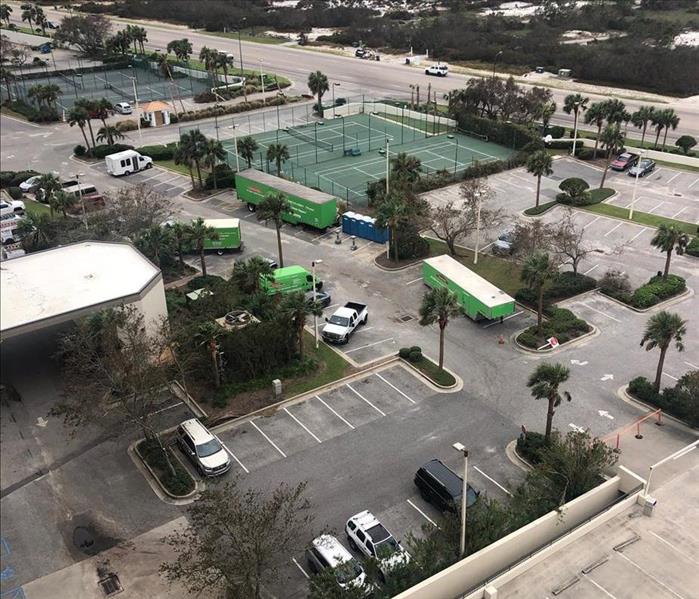 A few of our storm trucks stationed outside after Hurricane Sally
A few of our storm trucks stationed outside after Hurricane Sally
Ever get that eerie feeling? You’re cruising down a 4-lane highway and you’re the ONLY person on the southbound side of the road. Northbound is jam packed with cars and you can’t help but wonder, “What did I miss?”.
We get that feeling a lot, but wouldn’t categorize it as eerie, more just… this is what we do. When hurricanes, floods, wildfires, and natural disasters strike, SERVPRO is headed towards the storm ready to jump in and get to work.
Easy? Heck no. Never an adjective we’d use to describe storm response work. But, worth it? In every aspect of the word.
This year alone we have helped home and business owners in Cleveland, OH; Chicago, IL; Saginaw, MI; Philadelphia, PA; Bear, DE; Washington DC; Cleveland, OH again; and most recently, Pensacola, FL and Orange Beach, AL. And the year’s not over yet.
Team Wall’s Vision Statement is to “Restore peace of mind to EVERY customer. EVERY day.” At home, this is of utmost importance, but when running towards the storm to help those in need, this takes on a whole different meaning. People’s lives are rocked to the core by mother nature, a force completely out of their control. We send our seasoned team members to help walk these people step by step through the restoration process – from demolition, debris removal, drying, insurance coverage and approvals, and even rebuild – we are the facilitator and advocate for our customer to get them through a life changing event. And we love it.
We’d like to give a special shout out to our team members currently responding to storm damage caused by Hurricane Sally. You are special people and we can’t thank you enough for all you do!
Why Do Sump Pumps Fail?
9/7/2020 (Permalink)
Sump pumps are drainage systems that are commonly found in the basements of commercial buildings. They work to pump water out of the basement and away from the building, preventing flooding and water damage. A sump pump failure can lead to a flooded basement and cause water damage to furniture, essential materials, and other important objects, which could prove costly. Understanding why sump pumps fail is the first step in preventing a sump pump failure in your commercial building.
Causes
Power outages are one of the most common causes of sump pump failures, especially during the stormy summer months and hurricane season. Storms can dump large amounts of rain water for the sump pump to drain, but a power failure that prevents the sump pump from doing its job can leave your building defenseless and at risk for flooding. To prevent disaster, consider having your sump pump hooked up to a backup generator.
Sump pumps require regular cleaning in order to function properly, so infrequent maintenance can have serious consequences. To keep your sump pump from failing, clean its vents and run a vinegar solution through the unit.
Lastly, your sump pump might fail simply because it’s old. Over time, sump pumps will start to feel the effects of usage and therefore, failure is inevitable after 7-10 years. It’s recommended that your sump pump be replaced after 10 years in order to protect your building from a sump pump failure.
Sump Pump Failure? Call SERVPRO
If your commercial building’s sump pump has failed, resulting in water damage, remember that SERVPRO has you covered. We’re trained in flood and water damage and will use our trusted, advanced drying techniques to prevent mold and mildew growth, rapidly restoring any water damaged areas. Don’t hesitate. Call SERVPRO of Hunt Valley and Harford County today and learn more about the commercial water damage services that we provide here.
Is Your Business Prepared for Hurricane Season?
8/7/2020 (Permalink)
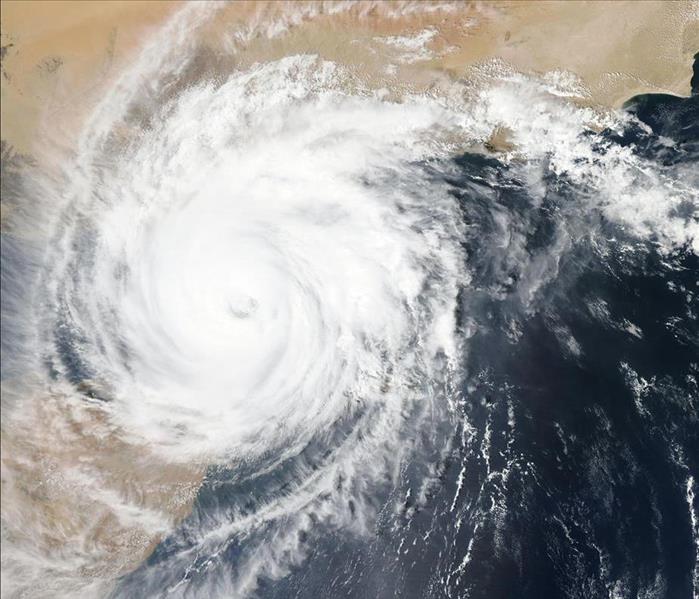 If your commercial business sustains storm damage during this hurricane system, remember that SERVPRO has your back and is ready to help.
If your commercial business sustains storm damage during this hurricane system, remember that SERVPRO has your back and is ready to help.
In the United States, hurricane season stretches from the beginning of June to the end of November. As we approach the latter half of July, we move closer to peak hurricane season on the east coast, which is typically the beginning of August through October. This year’s hurricane season has already proved to be intense due to the large number of storms that have been named thus far. In addition, a study from Colorado State University supports that this year’s hurricane season will be 50% more severe than the average hurricane season. In order to survive after a hurricane, it is crucial that commercial businesses have a hurricane emergency plan in place before disaster strikes. Consider the following proactive measures that your business can take to up your hurricane preparedness.
Take Action Before The Storm
Information is a critical component of every business. Having up-to-date contact information for every employee will facilitate getting in touch with them and confirming their safety should a hurricane emergency occur. During a time when many employees may be working remotely, being able to contact them is more important than ever. Additionally, essential data that the company needs in order to operate should be saved digitally if possible so that they can be accessed outside of the building, as hurricanes can destroy original documents. If creating digital copies is impossible, consider making additional paper copies and storing them in waterproof containers. Finally, steps should be taken to protect your property. Consider having a professional inspect your business’ roof prior to a storm in an effort to ensure that it can sustain strong, hurricane force winds. Investing in storm shutters can prevent windows and doors from sustaining damage from flying debris during a hurricane. Before the storm hits, sandbags can also be placed around doors in order to prevent flooding.
Have A Plan In Place
Physically protecting your commercial business and your employees is also of grave importance before a hurricane strikes. Create an emergency evacuation plan specific to your business, including which stairwells and doors to utilize if a hurricane were to hit while employees are in the building. It may be helpful to have employees familiarize themselves with the plan and post the physical copies in various locations throughout the building so that they will understand what to do during an emergency.
SERVPRO Is Here To Help
Taking precautionary steps can decrease the chances of a hurricane devastating your commercial business but during a hurricane emergency, there is always a risk that the storm will cause unexpected damage. If your commercial business sustains storm damage during this hurricane system, remember that SERVPRO has your back and is ready to help. Our professional, experienced storm damage experts will work to restore your workplace to its pre-storm condition.
Flash Floods: Know Your Risk
6/19/2020 (Permalink)
Summer rain showers can change from calm to severe in a matter of minutes. NOAA reports that flooding claims an average of 81 lives every year. While flooding in general is ranked the second most deadly weather-related killer in the United States, flash flooding can be even more dangerous. During a flash flood, rain rapidly creates a forceful rush of water that can destroy anything standing in its way, including buildings, roads, and homes. Due to the elevated humidity levels and slower jet stream characteristic of the summer season, flash flooding is particularly prevalent during the summer. Because flash flooding can strike at any given moment without warning, it is essential that you gain an understanding of how flash floods develop in order to best protect your home this summer.
Causes of Flash Flooding
The jet stream has a significant impact on weather events. During the summer, the jet stream slows, causing storms to spend a longer amount of time than usual over one area. As a result, the area experiencing the storm observes a large amount of rainfall and has a greater risk of a flash flood developing. Generally, increased duration and greater intensity of rainfall contribute to flash flooding. A handful of different storms, such as severe storms (hurricanes and tropical storms) and slow-moving thunderstorms, can produce these conditions.
Topography also plays a prominent part in the development of flash floods. If you live in a coastal town or any area located near bodies of water, including streams and rivers, you may be at greater risk for flash flooding. Urban areas are also at increased risk for flash flooding because they tend to lack drainage systems that can handle large amounts of rainfall.
Know Your Risk
Unfortunately, early warning can often not be given prior to flash floods due to the rapid rate at which they develop. Additionally, homes can undergo major water damage or structural damage when no warning is given before a flash flood. Therefore, it is of the utmost importance that you understand your area’s risk of flash flooding. If you live in an area that is at risk, be sure to stay alert when the forecast calls for storms. It may also be helpful to put together an emergency flood kit that you can have on hand during a flash flood. In the event that a flash flood strikes unexpectedly and results in damage to your home this summer, call SERVPRO. Our team of storm damage experts are here for you and will restore your home to its pre-flood condition “Like it never even happened.”
3 Ways to Prevent Wind Damage Due to Spring Storms
3/16/2020 (Permalink)
Spring storms, bringing the potential for severe thunderstorms, strong winds, and even tornadoes, have the ability to cause damage to homes. Specifically, strong wind can cause trees to break and damaged shingles, which can compromise the safety of your home. Wind strength varies from calm to hurricane-force depending on the storm. According to FEMA, strong winds most commonly impact roofs, doors, windows, and garages. Damage to any of those four areas of the home can potentially affect the structure of your home, requiring major repair. Before even hearing news that a severe storm carrying strong winds is on its way, there are several steps that you can take in order to protect your home from serious wind damage.
Maintain Landscape and Trees
First, pay close attention to any trees that surround your home, as wind can cause tree branches to break off or the entire tree to fall, thus risking damage to your home if trees are located close enough. Also, be mindful not to over-water trees, as over-watering often results in shallow, weak root systems, facilitating the possibility of trees falling during gusty winds. In addition, objects such as patio furniture, grills, or other backyard items can become projectiles during strong wind, which can damage your home if they are not anchored down or stored in a safe place, such as a shed.
Inspect the Roof
Because they are not in our usual line of sight, sometimes we are not aware of the condition of our roofs or shingles until serious damage has been inflicted upon them. In order to prevent unexpected, serious roof damage, survey the roof at least twice per year. Watch for loose or missing shingles and water damage in the attic, as both can be signs of damage. Hiring a roofing professional to inspect your roof may also help in spotting underlying issues that can save your roof from further destruction during strong wind. Finally, if possible, it may be beneficial to invest in weather-resistant shingles the next time that they need to be replaced.
Reinforce Windows and Doors
Utilizing storm shutters on windows and doors can help protect them from flying debris caused by strong winds. Storm shutters can be purchased but nailing plywood to windows and doors can also make for effective storm shutters. Lastly, garages cannot be forgotten. If particularly strong wind is expected, garage door bracing kits can be purchased, which will help keep the garage door in place during the storm.
Preventing Basement Flooding Due to Snowmelt
2/13/2020 (Permalink)
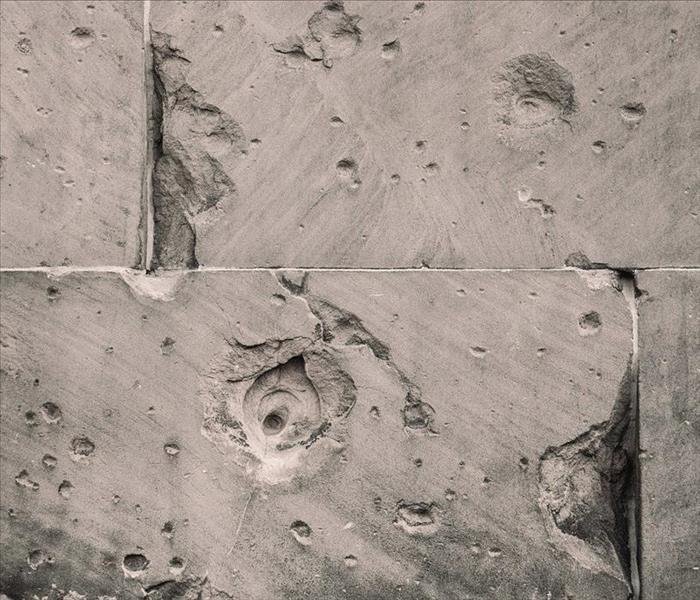 Commercial and residential damage both require the proper attention in order to mitigate properly.
Commercial and residential damage both require the proper attention in order to mitigate properly.
We commonly associate basement floods with rainy seasons, but did you know that your basement can flood at any time during the year as long as moisture is present? Even if yours has never previously flooded, most basements are prone to flooding because they are located below ground level. Moisture in the ground can seep through basement walls, which can result in flooding if there is an excess amount of moisture in the ground. During the winter season, winter storms often generate significant amounts of snow, ice, and other forms of freezing precipitation. After particularly heavy snowfall, the melted precipitation is absorbed by the ground, resulting in an excess of groundwater, which can make its way into basements and cause flooding. Consider these tips in order to prevent your basement from flooding due to snow melt this winter and spring:
Remove Snow
When shoveling snow after a heavy snowstorm, make sure to shovel snow at least five feet away from the foundation of the home in order to prevent the snow from immediately seeping into basement walls when it melts. This will create a special barrier between the moisture-packed soil and the basement’s foundation. In addition, it may be beneficial to clear snow from roofs and overhangs so that when snow falls or melts off of those areas, it will not land at the base of the home, contributing to more moisture surrounding the basement.
Fix Cracks in Foundation
Cracks in a basement’s foundation may facilitate flooding, as moisture would have an easier time seeping into the basement. In order to prevent a basement flood, which can damage valuables and facilitate mold growth, cracks must be repaired. Filling in cracks with epoxy can serve as a short-term solution, but a more permanent fix might require professional assistance. A solid foundation and walls will protect your basement from water, decreasing the chances of a basement flood due to snowmelt this winter or spring.
If Your Basement Floods…
Sometimes, even if preventative measures are taken, basements can still flood despite our best efforts. If this occurs, it is imperative that the water is removed as quickly as possible in order to avoid mold growth and further damage. If the flooding is minimal, using a wet vacuum to remove water and dehumidifiers to air out the area may be effective. However, if the flooding is significant, professional restoration may be necessary. Calling SERVPRO of Hunt Valley & Harford County will ensure that flood water will be thoroughly removed and that your basement will be restored "Like it never even happened."
Freezing Rain
11/20/2019 (Permalink)
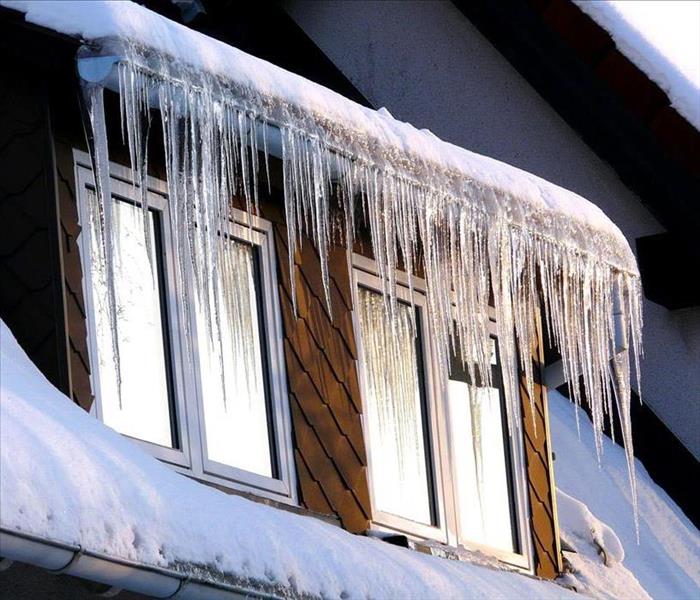 Frozen Rain stuck to a house
Frozen Rain stuck to a house
With colder temperatures moving in, the Hunt Valley and Harford County areas are beginning to see their first glimpses of snowfall and experience the first freezes of the season. During this time, the chance for freezing rain becomes heightened due to cold ground temperatures. Freezing rain occurs when the atmosphere is too warm to produce snow, so the precipitation falls as rain and freezes into ice upon hitting a freezing surface, such as the ground, roads, or bridges. Freezing rain can be dangerous due to its effects on roadways, sidewalks, and even power lines. For this reason, it is important to understand how to deal with freezing rain and what precautions you can take before a storm producing freezing rain.
Freezing rain is significantly more difficult to deal with than snow or other winter precipitation, as it cannot simply be shoveled. Because the rain forms ice upon hitting the ground, surfaces such as driveways, sidewalks, and roadways can become covered in a layer of ice that is not always easily visible. Icy roadways and surfaces often simply appear to be wet, which can be deceiving, as driving or walking on ice is significantly more dangerous than driving or walking on a wet surface. Another threat that freezing rain poses is the accumulation of freezing rain on power lines and branches. As the rain freezes into ice on the cold surfaces of power lines and tree branches, accumulate large amounts of ice, which weigh down upon them, eventually causing them to break. This can leave homes or businesses without power until power lines are repaired and risk damage due to heavy, falling tree branches.
With these dangers considered, it is beneficial to take precautions prior to a storm that is forecasted to produce freezing rain. Firstly, purchasing salt will be helpful so that you can salt your home or business’ sidewalks and driveways, which will begin working to melt the ice as soon as it hits the ground. Because freezing rain can cause power lines to break, your home or business could lose power for a certain amount of time. The ice produced by the freezing rain can also make it unsafe to leave your home until it has melted. In either of these cases, stocking up on essentials such as batteries, flashlights, toilet paper, bottled water, and blankets will alleviate the need to venture out of the house for those essential items while it is unsafe to go anywhere.
Surviving Prolonged Power Outages
10/11/2019 (Permalink)
 This could cause major damage to your home.
This could cause major damage to your home.
With the wind whipping, causing flash flooding and fallen trees, shattering windows, and damaging power lines in its path, we all fear the loss of electricity during a strong storm. Power can be knocked out for a few minutes or even seconds, but if enough damage is sustained, power can be lost for a longer period of time. Electricity provides us with many opportunities, from heating and cooling to preserving our refrigerated food. Without power, everyday tasks, such as communicating with others, storing food, and obtaining necessities, become more difficult. Considering the following tips in order to keep your family safe while you wait for the power to return.
Before the Losing Power
In the event of an emergency, you may need to utilize your cell phone. Without a method of charging, phone battery can deteriorate quickly, so cutting down on cell phone use can help to preserve the battery. One way to do this is to write down the numbers and addresses of important people or local hospitals ahead of time. Keep extra batteries at hand for electronic devices such as flashlights and radios. Preparing and eating food should also be an important consideration, as power outages take away our ability to cook or refrigerate food. To have food available, stock cabinets with items such as crackers or power bars that are non-perishable. Finally, have a back-up plan in mind for medications that require refrigeration in the event that your refrigerator is out of commission for an extended period of time.
During the Power Outage
Before scrambling to hook up a generator, remember that they should be as far away from your home as possible. Generators emit high carbon monoxide concentration levels, which can be deadly if the generator is placed within the home or garage. as high carbon monoxide concentration emitted from the generator can be deadly. Besides any electrical appliances being powered by the generator, all other electrical appliances should be unplugged, as they could suffer damage during power surges. Food inside of your refrigerator will spoil once the refrigerator loses its cool temperature, so it is crucial to keep refrigerator and freezer doors closed in order to preserve the food inside. Gas stoves can be used to heat food, as they can operate without power, but they should not be used to heat your home.
In the event that your home undergoes any serious damage, from flooding to ceiling leaks, call SERVPRO Hunt Valley in order to make it like it never even happened.
Hurricane Season: Are You Prepared?
9/3/2019 (Permalink)
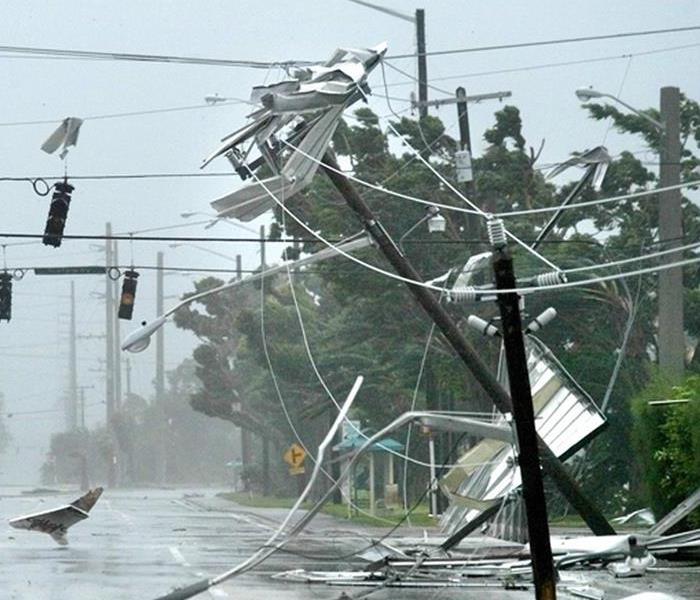 Hurricane Damage
Hurricane Damage
Hurricane Season: Are You Prepared?
September is on our doorstep and therefore, hurricane season is approaching quickly. Summoning strong winds, heavy downpours, and major flooding, hurricanes can wreak havoc on your home. September is also National Preparedness Month, a time when homeowners across the United States can focus on preparing their homes for hurricane season in addition to other natural disasters. Protecting your home from devastation during a hurricane begins with learning the most effective methods of keeping your home’s exterior in top condition.
Prior to hurricane season, it is a good idea to consider your home’s risk of being impacted by a storm, which depends on where you live. For example, if you live in a coastal area, your risk is elevated and you should take extra precautions. It is also important to understand what exactly your homeowner’s insurance covers. Make sure that your policy covers flood damage and rebuild costs if your home suffers devastating damage.
Before a storm, examine your roof and gutters. Missing or loose shingles are a red flag that your roof is damaged and may not be able to handle a strong storm. If your roof is already in poor condition, it’s more susceptible to damage from a hurricane. In addition to replacing shingles, it may also be helpful to seal your roof. Checking your gutters to make sure that they are clear of any debris will help assure that water will drain properly. If your gutters are clogged, water is more likely to splash up against the roof, imposing water damage on the roof.
Hurricanes can bring heavy rains and considerable flooding, so keeping as much water as possible out of your home can help to limit water damage. One effective way to prevent water from entering your home is to use sandbags, which divert flood water away from your home. Finally, check that your windows are sealed properly. Seals can break under the pressure of weather, such as intense summer heat. Without functioning seals on windows, rain water can seep into your home. Call a professional to ensure that your windows will be properly sealed before hurricane season hits.
Urban Flooding
7/22/2019 (Permalink)
With the prevalence of urban developments in our society today, flooding in urban areas is quite common. Cities are prone to flooding due to their lack of soil. Rain and flood water should theoretically be absorbed by soil, but since soil is scarcely found in cities, all of the water must be drained through draining and sewage systems beneath city streets.
This particular type of flooding can have detrimental effects on daily life, as standing water in city streets can block roads, preventing people from getting to work or school. A phenomenon known as “dancing drain covers” can occur when pressure or flood water builds up in drainage systems, causing covers to elevate off of the street level and shift their position off of the holes. This can prove to be dangerous, as vehicles attempting to drive on city streets will encounter those holes in the street and pedestrians could fall into the holes if they do not notice the absence of a cover.
When flooding hits urban areas, the majority of those affected usually do not receive the attention given to massive floods from hurricanes or major rivers, even though the damage may be just as serious. Therefore, it is imperative to understand the risk of flooding in your area if you live or work in an urban area. Coastal cities or cities situated near rivers are at a greater risk for flooding due to their proximity to bodies of water that could cause high tides or overflow respectively when impacted by heavy rain. If your home is located in an area that is prone to flooding, consider creating an emergency flood kit, filled with food, water, batteries, and flashlights in the event of a flood emergency in your city.
Job of the Quarter: Q3 2019
7/17/2019 (Permalink)
 Ken Matejek and our storm team celebrating their last night as SERVPRO heroes in the Iowa floods
Ken Matejek and our storm team celebrating their last night as SERVPRO heroes in the Iowa floods
We typically use this portion of our quarterly newsletter to describe a particular job we produced that sparked an out of the ordinary sense of pride and accomplishment by our team members. After reviewing the losses we have serviced throughout the 2nd quarter of 2019, it quickly became apparent that is was not just a singular job, but a new branch of our franchises’ business that has brought a sense of achievement to our team.
Ken Matejek has been an owner/operator of SERVPRO of Plymouth/Wareham, Massachusetts for 10 years. He bleeds green and believes wholeheartedly in the SERVPRO brand, but found what brought him the most joy and gratification was in helping those folks across the country affected by catastrophic storm situations. Ken took the leap of faith to simplify and focus his life on what he truly enjoyed. It was bittersweet, but he closed the doors to his Massachusetts franchise and began a partnership with Team Wall to make his passion for helping people in need a reality.
Since our partnership’s inception earlier this year, Ken and members of our travel storm team have helped service losses all over the country. They have been a part of Chicago’s deep freeze in February, Minnesota and Iowa’s spring floods in March, a microburst of flooding in June affecting a small portion of Central New Jersey, and most recently the DC floods this July. Between all of these storm travel experiences, we have helped over 115 homeowners nationwide make it “Like it Never Even Happened”. We are thankful Ken took that leap of faith to join our team and create a residential catastrophic storm response team that makes such a difference throughout our country. We’re looking forward to highlighting many more of their SERVPRO hero stories.
Surviving Summer Storms
7/15/2019 (Permalink)
Torrential rain and flash flooding hit the nation’s capital and various areas of Maryland, notably Frederick, Maryland, during the July 4th holiday weekend. The tremendous amount of rain that the thunderstorm carried caused widespread flooding, which transformed streets into rivers and caused even The White House basement to flood. Thunderstorms are most common during the summer due to the surplus of moisture in the air as well as rising warm air. These two factors combined together create prime conditions for thunderstorms. With their prevalence throughout the summer season and sporadically during the rest of the year, it is important to understand the threats to homes and businesses posed by the lightning and flash flooding brought by thunderstorms.
Damage Caused by Lightning
Lightning can cause both physical and electrical damage to homes and businesses if the building is directly hit by lightning during a thunderstorm. Lightning can burn through roofs, rip shingles or gutters from the building, and even tear into attics. In terms of electrical damage, lightning can increase the risk of an electrical fire igniting. Electronic appliances inside of your home, such as computers and refrigerators, can be harmed or destroyed if left plugged into an outlet during a thunderstorm.
Damage Caused by Flash Flooding
When a flood strikes your home or business, especially one like that which dumped excessive amounts of rain on Frederick, Maryland and Washington, D.C this past weekend, water levels can rise quickly and inflict a significant amount of damage. The flood water can carry mud and sediment, therefore contaminating the water and whatever it touches in your home or business. From this water damage, mold can grow and spread if the affected area is not remediated quickly. Flood water commonly affects drywall, flooring, and electrical systems such as cooling and heating systems, so it will be crucial to assess these areas for damage after a flood. On a larger scale, flood water can move houses or buildings off of their foundation, so be sure to watch for signs of that as well.
What to Do After the Storm
Immediately following the storm, survey your home or building for any visible indicators of lightning or water damage. This includes making sure that electrical breakers, outlets, and light switches are still functioning, checking plumbing systems for any leakage, and looking for any visible signs of water damage to items within the house or building. While cleaning up any damage, be sure to turn off all water and electrical systems so that when the electricity is restored, the water and electricity do not react with one another, which would result in further damage.
Flooding in Iowa
6/22/2019 (Permalink)
This May, SERVPRO crews traveled to Burlington, Iowa, after 13 inches of rain inundated the region over a 2-day period. Along with rain, golf ball-sized hail, high winds, and tornadoes rocked the area, resulting in widespread flooding as well as the flooding of nearby rivers.
At the time, Iowa also happened to be recovering from a major snow melt, which flooded the Missouri River earlier in the year. A record-breaking 25 inches of snow fell in Des Moines, Iowa during February of this year. After the extensive snowfall, the ground was unable to absorb any more liquid due to the soil saturation, and the 13 inches of rain spread across the ground, flooding highways, roads, and homes. SERVPRO received approximately 30 job files and three crews were sent to Iowa for this restoration.
Flooding can contaminate and damage drywall, support beams, and the foundation of homes. The damage to homes consisted of wet finished basements that range from 500 square ft to 3,000 square ft, wet flooring, walls, and content. The risk for mold to grow is most heightened during the first 24 hours of the flooding, so remediation had to be hasty.
The most rewarding aspect of working the Iowa storm was the ability to help flood victims’ lives return to normal as well as the good feeling that arises from helping those affected by the floods!
Broken Pipes in Chicago
6/22/2019 (Permalink)
In Chicago, Illinois, five consecutive days of -50 degree temperatures froze over the windy city, turning The Chicago River to ice in its path. These frigid temperatures were then followed by a heat wave just shortly after the deep freeze, with temperatures soaring into the upper 40s and 50s. This radical shift in temperature caused Chicago homeowners’ pipes to break.
This occurrence is not, however, specific only to Chicago. Pipes can burst and initiate flooding wherever conditions are favorable. The water carried by pipes tends to freeze over when faced with negative temperatures, so when those subzero temperatures rise, the water begins to thaw and the pressure inside of the pipes increases until it reaches its maximum. The pipes then burst, resulting in flooding.
Flooding caused by burst pipes can trigger a wide range of water damage: carpets and even walls can be prone to water damage as a result of burst pipes and basements can flood. Mold commonly grows in flood-damaged homes or damp areas, as the moisture allows for mold to grow and multiply. To protect against mold, objects that cannot be cleaned, such as drywall or ceiling tiles, should be removed, while items such as glass or ceramic may be cleaned.
SERVPRO was presented with about 30 job files and three crews were required to confront the issue. Among the factors motivating the crews to make the journey to Chicago were the elation surrounding the prospect of helping victims to recover and devising a plan to combat the widespread flooding.
How to Maintain a Sump Pump
9/24/2018 (Permalink)
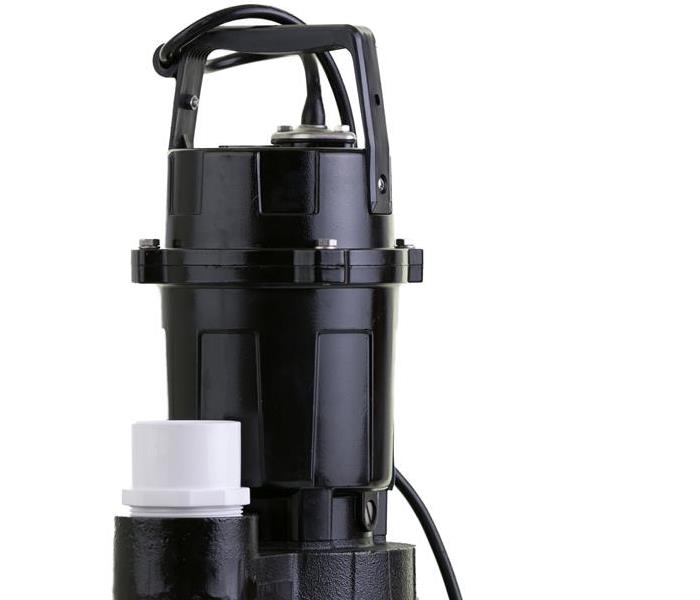 Sump pump ready to prevent flooding in Towson North, MD
Sump pump ready to prevent flooding in Towson North, MD
A sump pump is a handy tool, especially in Towson North, MD, that helps to prevent flooding; however, it does require a certain level of pump maintenance to ensure that it is always operating to its full capability. To maintain your pump, there are six areas that you should check before severe weather hits.
1. GFCI
Every so often, it is important to check that the Ground Fault Circuit Interrupter (GFCI) that your unit is plugged into is properly working. To ensure the outlet is working correctly simply plug any electronic into it and make sure that you can power it on.
2. Discharge Pipe
As an essential part of any pump operation, the discharge pipe can become clogged by debris, like dirt and gravel, so it is necessary to inspect the pipe and clean out any blockages.
3. Intake Screen
Like the discharge pipe, the intake screen of your pump can become clogged with debris and will need to be cleaned once in a while to ensure the free flow of water.
4. Float Component
The float mechanism in the sump pump housing can become obstructed, which means that it will not activate the pump mechanism. This area of the pump should be inspected regularly for debris to ensure proper operation.
5. Pump
The pump mechanism can be tested by merely pouring a bucket of water into the pump basin. As the float rises in the water, it should activate the pump. If the pump does not activate and there is no debris, you may want to call in a professional to inspect it.
6. Battery Backup
Many pumps come with a battery backup. If your pump is one of these types, then every few years, 2 to 3, you will want to replace the battery.
A sump pump, while an essential tool in the prevention of home flooding, is not without its quirks, and it is normal to have to perform routine maintenance to keep it functioning as intended.
Don’t Blame the Rain: Other Ways Storms Can Damage Your Business
8/22/2018 (Permalink)
 Pipe break after significant rain and storm can cause flooding in your home
Pipe break after significant rain and storm can cause flooding in your home
When a huge storm rolls through Towson, MD, you might worry most about heavy rains. After all, significant rainfall can find its way into your building and flood your office. However, this isn’t the only flooding that can occur, nor is it the only concern you should have with storms. It’s important to be aware of dangers such as a burst pipe, or flooding situations so you can prepare and act appropriately.
Pipes Burst
Within the plumbing and water systems of your office building, there is a network of pipes carrying water, sewage, and possibly other chemicals throughout the facility. A burst pipe could empty gallon upon gallon of water into your building, leaving standing water and severe damage. Here are a few ways in which pipes burst:
• Pressure buildup
• Corrosion
• Extremely cold temperatures
If a winter storm brings low temperatures, you may be at risk for these issues. Make sure your building has sufficient insulation and that you drain any outside lines before winter hits.
Pipes Freeze
If your building pipes do freeze, you need to act quickly to ensure they don’t burst and cause flooding. A professional restoration company can help you clean up the mess and mitigate damage, but you don’t want to get to that point if you can avoid it. If you do find a frozen pipe, keep faucets open, as running water can help melt the ice. You can treat the pipes by wrapping pads around them, or you can even use space heaters.
Pipes Flood
At worst, bursting pipes can cause significant flooding and render your office unsafe. The floodwater can damage furniture, carpet, walls, or equipment. Also, a frozen pipe could prevent water from reaching the building.
As winter approaches and during large storms, make sure you keep an eye on your interior and exterior pipes. A little effort and mindfulness can help prevent the major disasters a burst pipe can cause.
For more on Towson click here.
Setting Those Stormy Expectations
7/26/2018 (Permalink)
 Storm Waters can cause flooding in your Maryland neighborhood
Storm Waters can cause flooding in your Maryland neighborhood
If your home suffered damage as a result of a storm in Towson, MD, complete and accurate restoration is your overall end goal. Storm restoration can only be achieved after you assess water damage, tear out appropriate items and reconstruct as necessary. It is critical to manage your expectations of damages. Understanding the process involved can minimize your storm stresses.
1. Extraction of Water
Begin water extraction by making sure it is safe to be inside your property. Opening doors and windows allows pooled water to drain. Mop saturated areas and blot floors and walls with towels and other dry materials. Move wet furniture and articles into the driest spaces available and turn the air on in your house (blasting the air conditioning in summer or heat during winter).
2. Tear Out of Wet Materials
Removing wet materials from your home in a timely manner is crucial. Mold quickly begins to form on items that are not dried, removed or torn from their location. Extremely damaged carpets or drywall should be removed, though take care not to tear any loadbearing structures from your home without seeking a professional opinion.
3. Drying of Structures
Dry and dehumidify structures as soon as possible. Ceiling fans and box fans can be utilized to dry open areas of the home. Certain areas of your property are harder to access; however, restoration service professionals should have advanced methods, including industrial fans and treatments, to reach these areas and shorten the drying process.
4. Restoration
The last and final step of restoration varies in scope. Occasionally only some drywall and furniture will need to be replaced, while other instances may require expansive rebuilding and landscaping.
Dealing with a storm and its aftermath can be a tricky, cumbersome experience logistically and emotionally. It is important for homeowners in Towson, MD, to know what to expect as they deal with the cleanup process. Remember before, during and after the storm that you have four basic steps to complete in order to restore your home to its previous glory: extract, tear out, dry, restore.
For more on Towson click here.
Cleaning Up Your Business After a Flood
6/13/2018 (Permalink)
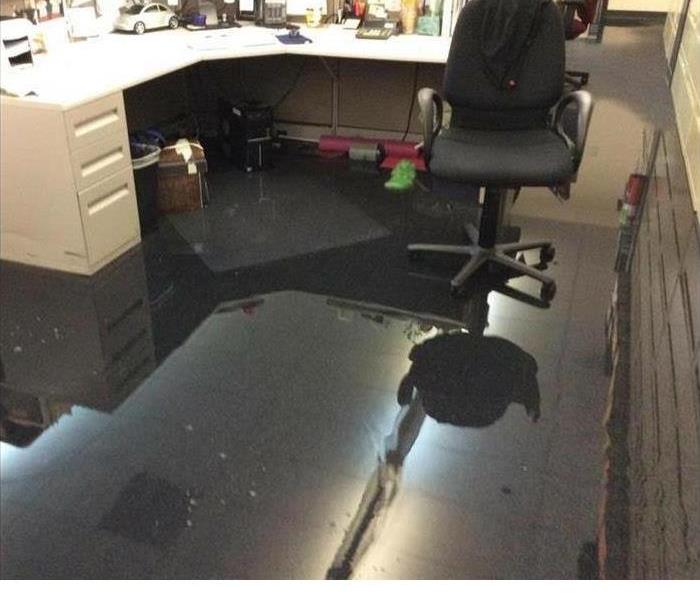 Commercial Flooding in Towson, Maryland
Commercial Flooding in Towson, Maryland
Floods are dangerous and unpredictable, and they rarely recede without leaving their mark. The problem is that floodwater isn’t usually clean water – it can be filled with sewage, termed “black water” – and is not always easy to clean up. Whether from a storm, a busted pipe or a sewage overflow, facing the aftermath of a flood is never fun for any business.
If you’re worried about flooding in your Towson, MD, business, then it’s important to become familiar with some of the basics of content cleaning after such an event, such as what can be disinfected and restored, and what must be thrown away.
What To Throw Away?
Unfortunately, not everything survives a flood. Some things simply have to go. Here is a list of items that often need to be disposed of during the content cleaning process.
• Porous materials – contaminated wood, drywall, insulation
• Medication and food
• Furniture made with veneer or upholstery
• Carpeting and rugs
• Books
What To Keep?
Not everything in your business will likely be destroyed by contaminated floodwaters. While these tips can help you identify what can be saved, a content cleaning service can certainly help to speed things along. Here is a list of salvageable items that can potentially be sanitized and restored.
• Nonporous items – objects made of metal, glass, porcelain, hard plastic, silver, etc.
• Photographs
• Carpeting (only if floodwater is not contaminated)
• Wood furniture (if not soaked for too long)
• Appliances – heating, air conditioning, air ducts and vents
• Textiles, linens and clothing
What To Do After?
Although some items will need to be discarded and others can be restored, it’s important to remember that the best mitigation measure your business can take is to prevent disasters before they have the chance to happen. Whether you’ve suffered flooding already or are just planning ahead, it may be worth upgrading your business’s infrastructure so that it is more prepared for floods, storms and sewage overflows in the future.
Take measures to prevent a flooding from happening to your commercial building. However, if black water does enter the premises, take note of what can be saved and what must be thrown away when cleaning up afterwards.
For more on Towson click here.
Towson Flood Damage - Overcoming Flood Damage in Towson
5/24/2018 (Permalink)
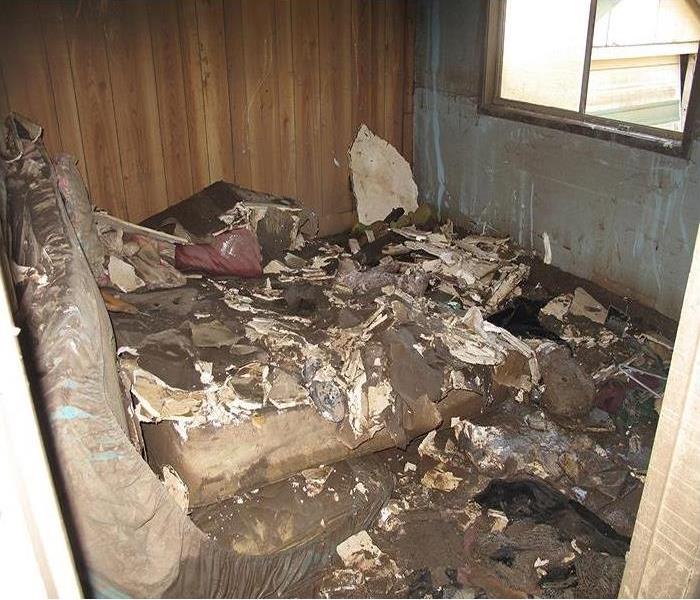 Towson Home Damaged from Flooding
Towson Home Damaged from Flooding
Call SERVPRO for Towson Flood Damage Remediation
The unfortunate reality is that many homeowners will have to contend with flood damage Towson at one time or another. Flooding can occur for any number of reasons, such as a leaky or burst pipe, a natural weather event that brings floodwaters into the home, and more. Whether you have a few inches of water or several feet or water in your home, you need to find a company that offers a fast response to water remediation and flood damage in Towson if you want to return your home to normal.
Why a Fast Response Is Needed
Water may be an essential for life, but it also can be very destructive. Consider that water can cause your wood furnishings and fixtures to warp, mold or mildew. Mold can begin to grow on various other surfaces when water is not removed promptly. In addition, water staining is common. Such issues with staining, warping and mold growth can wreak havoc in your home, but you will find that the damage to your property is significantly reduced when you set up fast efficient Towson flood damage service. Keep in mind that mold and mildew damage can quickly spread to other areas of the home where water damage is not present, posing a health and safety hazard to your loved ones. Preventing the growth of mold in the home is a top priority, and a fast response to water damage is the best option to take.
What to Expect From Flood Damage Services
While flooding is common in homes in this area, you may have never had a reason to contact a professional service provider for Towson flood damage services in the past, and you may not know what to expect from the service. With SERVPRO of Hunt Valley / Lutherville, you can expect a team of skilled and hardworking professionals to arrive at your home promptly and begin extracting the standing water from the home. As soon as the standing water has been removed, additional steps will be taken to reduce the humidity level in the home. Keep in mind that high levels of moisture can be almost as damaging to a home as water itself. The restoration work will begin once the water and humidity have been removed.
When to Call for Help
If you have discovered standing water in your home, you may not be certain when you should contact a professional for assistance with water remediation services. Towson flood damage services are available to help you with all aspects of water remediation, and this includes water extraction, which should begin as soon as possible. This can start as soon as fresh water is no longer pouring into the home. After you have turned off or stopped the flow of water into the home, you can begin eradicating the water through remediation services.
Water damage can be difficult to deal with, but there is a fast and easy solution to your problem available. Call SERVPRO of Hunt Valley / Lutherville for Towson flood damage services. As a locally owned and operated company, we have the resources and personnel to help restore your home. Contact us today at (410) 229-0012.
Safeguarding Your Home Against Potential Flood Damage
4/16/2018 (Permalink)
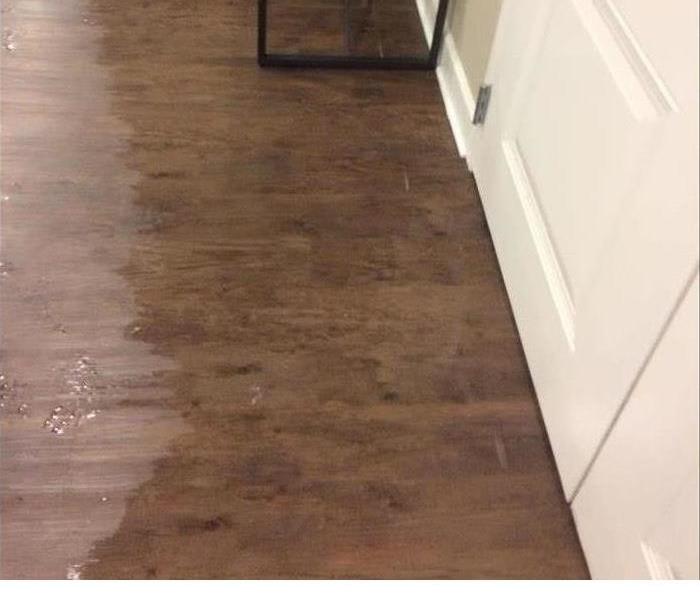 Severe Flooding Damage can ruin your Hardwoods in your home or business
Severe Flooding Damage can ruin your Hardwoods in your home or business
When there’s a severe storm making its way toward your Towson North, MD, home, the most important task is to get you and your family out of harm’s way. However, if you have a few days to prepare for a potential flooding event, there are ways to organize and safeguard your property from impending flood damage. Help eliminate your chances of getting hit with extreme storm damage by following these few handy rules for flood preparation.
? Elevate your electronics and necessary utility panels. Place any objects like wiring, sockets, appliances, electrical panels or heating systems at a higher elevation in your home if possible, or simply disconnect them before you leave to prevent a potential electrical fire before any flooding occurs.
? Waterproof your basement or cellar. This can help protect your valuables from becoming part of the flood damage, as well as prevent the interior drywall or insulation from soaking up excess water — a situation that could potentially lead to mold growth later on.
? Clear away any debris caught in your home’s gutters, downspouts or storm drains. Any buildup in these areas won’t allow water to flow naturally, which can cause it to get backed up and seep into your home. Clearing the way gives the water a place to escape and increases the likelihood of your home avoiding a major flood issue.
? Move your home’s furniture and valuables to higher ground if the option is available. Keep all important documents such as birth certificates, marriage certificates, social security cards and the like contained in a steel lockbox or safe that won’t be affected by the presence of water.
Though it’s nearly impossible to be prepared for every extreme weather event that occurs in Towson North, MD, it is possible to take preventative measures to secure your home from the worst that flooding can do. Furthermore, seeking professional help from restoration specialists to clean up and secure your property after a disaster can help you return home that much faster.
Click here for more on Towson North.
Identifying Your Flood Water Threat Level
3/12/2018 (Permalink)
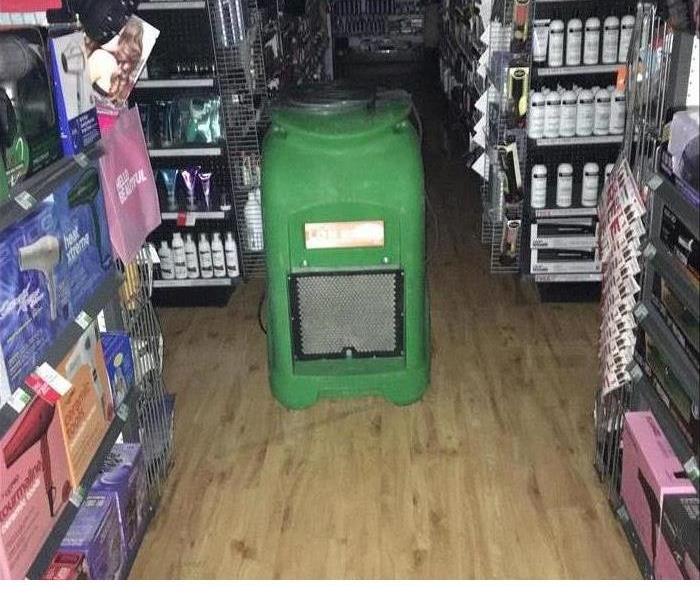 Commercial Store Flooding
Commercial Store Flooding
No flood is a good flood, but did you know that some floods are much more dangerous than others? Flood water is graded on a system, ranging from clear, safe water to “black water,” which tends to carry a wide range of dangerous contaminants. In order to keep your business and employees safe in the aftermath of a flood in Towson North, MD, it’s imperative to learn the defining qualities and natures of:
• Clean/Clear Water
• Gray Water
• Black Water
Learning the differences could very well help to save a life while you wait on your preferred cleanup crew to arrive.
Clean Water
This type of flood typically results from broken water lines, rainwater, toilet tanks and snow melt – sources of water that’s typically considered clean enough to drink. While floods of this water type can be pesky and promote mold growth, they’re not considered a health threat.
Gray Water
Gray water is, simply put, water that comes from sources that may be tainted with chemicals. This can include dishwasher and washing machine overflows, aquariums and other household belongings that deal with water and any sort of cleaner. While it’s mostly harmless, this type of flood water should still be handled by a professional cleanup crew.
Black Water
This is the type of water you’ll find in the aftermath of heavy storm damage, septic tank issues, sewage backup and other issues where unclean water and fluids find a way into your business. This water is likely to carry a wide range of bacteria and diseases, and has a high likelihood of making those who come into contact with it ill. A professional team should always be consulted for cleanup.
Identifying your flood water type is only the first step, of course. You’ll need to work alongside a team of professionals to dry out your property, replace damaged flooring and perform other restoration tasks to get your business back in shape. However, learning the difference between clean water and dangerous water can go a long way towards creating a safe cleanup environment in the meantime.
Visit us at http://www.SERVPROhuntvalleylutherville.com for more information.
2 Instances When a Flood Cut Is Necessary
1/8/2018 (Permalink)
Extreme flooding can leave you with a basement in a state of disarray. To get the room back to normal, a professional team from Cockeysville, MD can attempt a tear out known as a flood cut. This is when the team removes a portion of your drywall, usually 12 inches above where the water damage ends. While it is not necessary in every single case, most homeowners will find a flood cut to be highly advantageous.
1. When the Water Is Contaminated
When your home has been flooded with normal, clean water, the team may not have to cut out any part of the drywall. However, flood water can carry various hazardous substances, including
• Raw sewage
• Fecal matter
• Chemicals
• Other forms of contamination
Flooding with these substances can result in a variety of problems, and it may mean parts of the walls need to go. It is the only way to ensure the pathogens are removed from the building entirely. This most often occurs when the inside of a house has been flooded from the sewer line. Anything the sewage touches needs to go.
2. When the Walls Have Insulation Behind Them
If your basement walls do not have any insulation behind them, then the professionals may be able to dry the other side of the walls with a technique known as injectidry. This is when small holes are drilled into the wall and the experts use them to carefully dry the interior. However, if there is insulation, then a flood cut is necessary. It is practically impossible to dry insulation, so the walls will need to go to get the insulation out from the area.
When it comes to extreme water damage, professionals sometimes need to resort to drastic measures, but it is to ensure your house is safe to inhabit. If your house in Cockeysville, MD ends up flooding, then you can ask the experts what they would recommend for your specific scenario. Visit http://www.SERVPROofhuntvalley.com for more information on storm damage.
How a Flood Cut Can Protect Your Property
12/18/2017 (Permalink)
How a Flood Cut Can Protect Your Property
Whether it is from a hurricane, a downpour or a broken drain line, each flooding event is unique. Flood restoration experts are trained in a variety of cleanup techniques and know how to operate industrial and technical equipment needed for the job. One of the more advanced techniques they employ is a flood cut. Here are four questions commonly asked about flood cuts.
What Is a Flood Cut? After a room has flooded, an area of drywall is often cut out and disposed of. That cut is usually 12 to 18 inches above the line of water damage, which means that flood damage cleanup technicians will tear out a bottom section of the drywall. This enables a more efficient removal of materials that were tainted by the water.
When Is a Flood Cut Necessary? There are several situations where a flood cut is needed:
In the case of sewage backups
When there is insulation behind the walls
When there is chemical contamination
When harmful pathogens might be present
When Is a Flood Cut Not Needed? In cases where the flooding is from clean water, and where no insulation is present, a flood cut will most likely not be needed. In this situation, the room can be cleaned by normal methods of pumping out the water and then using vacuums and fans to dry the area.
What Happens After a Flood Cut Is Performed? This depends upon the situation, but in most cases, a flood cut allows for a more thorough cleaning and drying out of the affected area. Once that is completed, a contractor can come in and replace the drywall and the insulation.
Flooding in Towson North, Maryland is always a traumatic event, but not every flood should be handled the same way. It’s important to become educated on the various flood damage restoration options before the waters flow. Visit http://www.SERVPROofhuntvalley.com for more information on flood damage.
What to Expect From Storm Damage Restoration
9/26/2017 (Permalink)
What to Expect From Storm Damage Restoration
Hurricane damage, storm damage, wind damage, ice damage and hail damage can wreak havoc in your home. When this happens, you may feel like all is lost. However, you will be surprised by how much can be saved through expert home restoration or storm remediation. Before you count your losses, give storm restoration a chance.
Home restoration services can be sought after calamities such as hail damage, river flooding, ice damage, wind damage, flood water damage, ice damage and hurricane damage. It is best to have the contacts of experts on storm remediation. This is especially in the wake of the recent hurricanes rocking the country.
Another harsh weather element is wind damage after a storm. Wind damage can cause extensive roof damage. This happens due to loose shingles or tiles. Wind damage can also cause moisture from ice dams or ice damming to penetrate the roof. This can lead to wood swelling. The outcome is a sagging ceiling and roof damage which needs extensive roof repair.
The ice dams or ice damming also pose a risk to the roof. A roof leak can develop into a crack. This has the potential to damage the structure. Ice damming also weigh down the roof due to the ice dam pools. Homeowners who live in areas prone to wind or winter damage should consider roofs with a higher slope to reduce roof damage. This will reduce the need for regular roof repairs and the possibility of a roof leak. A roof leak from ice damming or formation of ice dams should be repaired immediately. Putting off a roof repair means that the homeowner incurs more costs later.
Roof inspection before the harsh weather also minimizes the roof repair costs. Any broken or lose shingles should also be fixed. Storm restoration experts will advise you on the appropriate roof repairs to be done ahead of any harsh weather. They will also assess the roof leaks before they get worse.
When you engage the services of storm restoration experts after flood water damage, storm damage, ice damage, hail damage, river flooding, wind damage, flooding or hurricane damage, the experts are sent to your home immediately. The water restoration efforts begin after a careful assessment of the flooding.
The water restoration professionals will also conduct an examination of the exterior and the interior of the home. They also check the extent of the flood water and ground water levels. This helps them to come up with the home restoration plan based on the flooding, storm damage and ground water.
The teams work together after agreeing on where to start. Hurricane damage, storm damage, hail damage, flood water damage, roof damage and ice damage all have different water restoration processes. It is ill advised for home owners to attempt the storm restoration process without seeking professional storm remediation.
Storm remediation. experts also come equipped with the appropriate work gear and tools. An important tool is in the water restoration process is a flood pump. Flood pumps are designed to drain water in flooded areas. These flood pumps can be placed in rooms and left to drain the ground water automatically. The floods can also handle ground water as it rises to higher levels. River flooding pumps are also available for extensive flood water damage. Flood pumps are also used alongside vacuums.
Winter damage is another common weather calamity. Winter damage leads to frozen pipes. The frozen pipes are not able to allow for the flow of water. It can take time for the frozen pipes to unfreeze. It is best to call in the experts to deal with the frozen pipes. Applying heat on the frozen pipes can lead to damage and the pipes may need replacement.
Today, home restoration and storm restoration experts are fully equipped to handle flooding, river flooding and other harsh weather elements. Enlisting their services in good time can help to save your valuables after a storm.
Visit http://www.SERVPROofhuntvalley.com for more information on storm damage.
Restoring Your Property In Cockeysville After A Flood
5/23/2017 (Permalink)
 Storms can force an incredible amount of water through a home in a very short amount of time.
Storms can force an incredible amount of water through a home in a very short amount of time.
Flood Damage Repair
Storms can force an incredible amount of water through a home in a very short amount of time. The flood waters left behind can be clean or contain dirt and other soils which complicate the cleaning and restoration process. Regardless of what is in the water, it is the amount of time that it covers floors and personal property that causes the most damage.
Restoring a Cockeysville home from the effects of flood damage requires training and patience. When it comes to saving moisture soaked hardwood floors, SERVPRO has developed a set of procedures which take into consideration the time under water, moisture levels, and how to prevent cupping, warping or buckling.
All three effects on hardwood floors begin quickly after exposure to excess water. Our task is to keep it from becoming permanent. We eliminate cupping and warping by sanding down the bulging or twisted areas. Technicians disguise this action by making it part of the refinishing process to keep the wood surface with a smooth look. Sanding is very efficient unless the damage is very severe; if it is, then we remove the damaged board and sand a replacement to match the shape and appearance of the original wood. Buckling damage is more evident, but it can be sanded down in some cases. More often, our technicians remove the buckled wood and then sand a replacement to match.
Before we start any work on the floorboards, we test and lower the moisture content. If the moisture levels are very high, it may take four weeks or longer before we can begin work without causing secondary damage to the wood. The level must test out to twelve percent or lower to avoid this.
We start by reducing the relative humidity of the room to under forty-five percent. Technicians set up air movers to force airflow over and under the floorboards. Lowering prevents most of the damage and reduces the chance of mold growth after we get the humidity under twenty percent. Once the levels test under sixteen percent, we use specialized heaters to raise the temperature of the room to speed up evaporation.
Some varnishes and other floor finishes act as a vapor barrier. They slow and even prevent evaporation from happening. If our technicians determine this is the case, they use a pin roller to carefully pierce the finish in corners and out of the way areas. That increases the effectiveness of the air movers and speeds up evaporation.
Repairing and restoring your home after a flood can be a lengthy and expensive process. It is best accomplished by a professional company to avoid subsequent damage and keep costs to a minimum wherever possible. SERVPRO of Hunt Valley / Lutherville helps you through every step. Call us today at (410) 229-0012.
Looking to learn more about Maryland click here http://www.maryland.gov/Pages/default.aspx
Reconstruction Efforts in Towson North
4/11/2017 (Permalink)
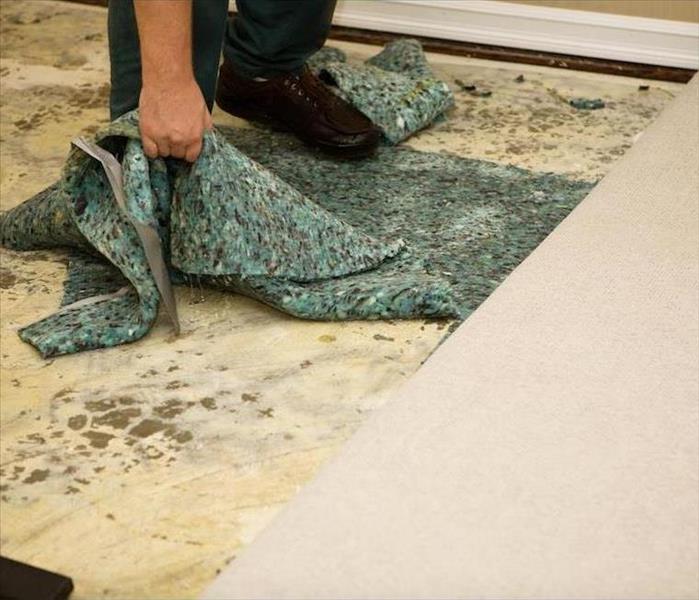 Some damaged carpets may need to be replaced after your home experiences a storm damage event. Call us to discuss and start the restoration process.
Some damaged carpets may need to be replaced after your home experiences a storm damage event. Call us to discuss and start the restoration process.
Your Home Can Be Restored By SERVPRO Technicians After Experiencing Storm Damage
Storms in our state (not to mention all of New England) have broken records over winter and spring so far. Rainfall has been excessive, and the winds have knocked down more trees than many residents have ever seen. Unfortunately, this also means area homes have suffered more damage than in previous years.
Storm reconstruction needs to be done by a professional service, regardless of the extent of the damage to your Towson North home. SERVPRO has decades of experience in reconstruction and restoration of homes and businesses after storms, and other disasters have happened. We are licensed to handle all aspects except major construction (building a complete, new roof for example); from reframing interior walls to that final coat of paint on the trim of your new windows.
After we remove all damaged property and secure the home from the weather and trespassers, technicians start with the interior. If wood flooring is damaged, we replace the affected pieces and stain the new ones to match the existing area. In the case of carpets damaged past restoration, technicians pull up the carpet and pad and replace the tacking strips before laying new carpet.
With the floor back to its original state, technicians install new wall framing. We carefully measure to match the original floor plan and then hang new drywall or other paneling to return your rooms to their pre-damage dimensions and appearance.
Now, our team repairs the ceiling. If the damage is extensive, we recommend pulling down the framing as well as the tiles or panels. Our team members can install a wood or aluminum frame depending on the type of ceiling you choose to place in your home. If there are beams in the attic that need to be replaced or require additional support, our technicians are trained to do that as well.
Finally, we return the face of your home to normal. Our reconstruction crew can replace the windows and doors in most households in a single day. We can also reframe many windows and doorways if you decide to change the type or size of your windows and doors.
Although severe storms are not in the forecast, there is more rain expected this week. Contact us here at SERVPRO of Hunt Valley / Lutherville to begin reconstruction before further damage happens to your home. Call today at (410) 229-0012 to begin.
Flood Damage can Harm Your Home, Your Belongings, and Your Health in Hampton
3/22/2017 (Permalink)
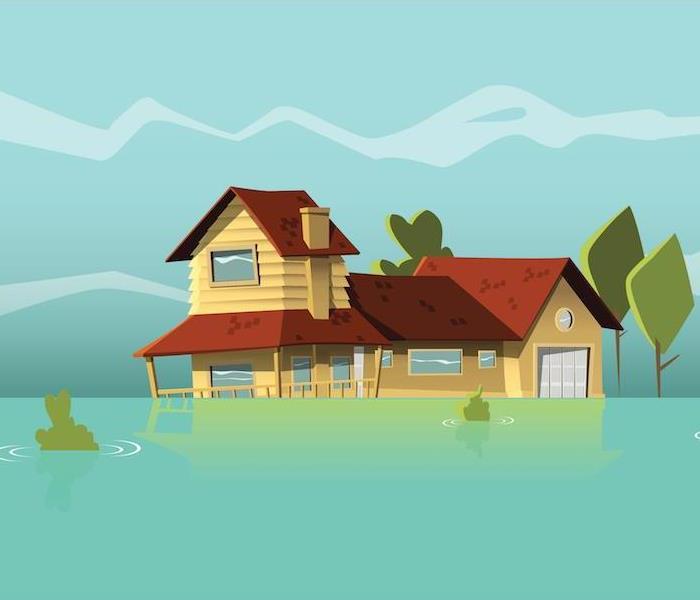 Flooding happens. SERVPRO's quick response can resolve the issue fast and with less chance of secondary damages.
Flooding happens. SERVPRO's quick response can resolve the issue fast and with less chance of secondary damages.
SERVPRO's Quick Response Can Help Prevent Mold Growth
Flooding in your home can happen in several different ways. A broken water line or kids playing a prank with a hose placed through a window and then turned on can fill a home with water faster than might seem possible. Sewer backups from clogs can also happen. Moreover, there is always the traditional flood, caused by too much rain or melting snow.
Regardless of how your Hampton home goes underwater, any of it can cause flood damage. Even clean water from a busted water line or a misplaced hose can cause enormous amounts of water damage. This water can also become contaminated and create health problems in addition to the damage it causes to walls, floors, furniture and doors.
With flood damage, SERVPRO knows that we need to remove as much water as we possibly can and as quickly as our trucks can pump it out. For smaller floods, any secondary water damage can still affect the entire home if it is not sufficiently removed.
Water will damage many items on contact, including walls and floors. Painted walls can bubble or blister, and those with wallpaper can do the same. Both types need to be replaced wherever there is damage. Floors can either be damaged and swell, causing dangerously weak areas or warping, depending on the floor type.
Walls and floors must be repaired or even replaced for your home to be safe again. Quick action can decrease the amount of damage and save thousands of dollars over waiting. These areas of your home cannot easily dry out by themselves as they are saturated on the inside. Waiting leads to increased deterioration.
Furniture can also end up in bad shape because of flood damage. SERVPRO can restore furniture so that it no longer poses a risk of harming someone. If mold has begun to grow, or if metal fasteners have rusted, this can cause once safe furniture to become unstable, and also dangerous. The metal pieces can also become loose because swelling and shrinking of the wooden parts they are attached to will allow them to come loose.
Secondary flood damage includes mold growth in areas of your home. These areas may not have been affected by the flooding to begin with and can be anywhere in your home. Quick and prompt attention to the initial flood damage can stop this from happening.
When flood damage is destroying your home, call us, SERVPRO of Hunt Valley / Lutherville at (410) 229-0012, and we can arrive within an hour after your call.
The Hidden Dangers of Flood Damage
11/27/2016 (Permalink)
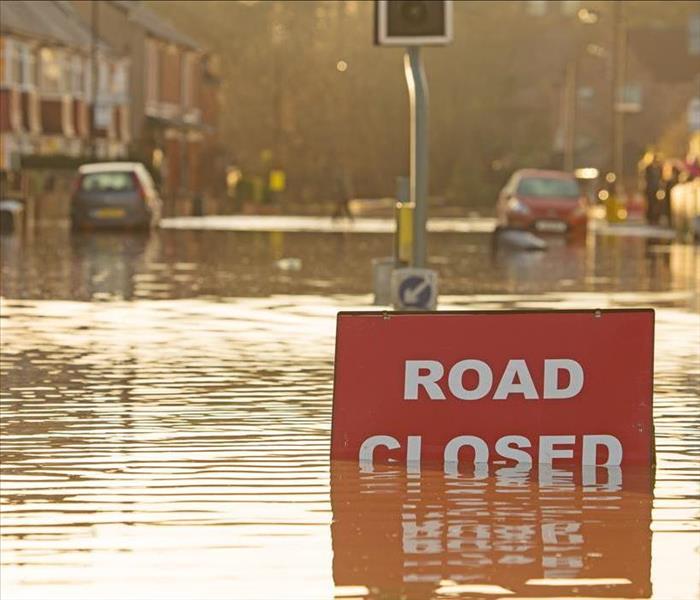 Fast Water Removal Mitigates Storm Damage to Your Parkton Home
Fast Water Removal Mitigates Storm Damage to Your Parkton Home
Cost of Flooding Includes Extraction of the Water and Salvaging Possessions
Dealing with flood damage is troublesome and stressful enough, but such a water emergency also leaves behind some hazards and dangers. Many issues do not become apparent until well after the water has been extracted from a home, but they can be just as disastrous the water that caused the problem in the first place.
Being a homeowner with flood damage in Parkton, it is important that you know what dangers can lurk well after the water is gone. Here's information about the side effects of flooding and how SERVPRO can help get your home back in great shape.
Mold
Mold is one of the most notorious secondary water damages associated with flood damage, and it can lead to health effects in humans and animals. It is also unsightly and causes bad odors that are difficult to eliminate. Whether your home had dormant mold spores that became active during a flood or new spores have started to grow, our technicians can spot and help remedy the situation.
Damage to Electronics and Appliances
Water and electronics are never a good mix, but the damage typically goes beyond causing appliances and electronic devices to stop working. It can also cause wire corrosion and electrical fires, and even devices that aren't directly exposed to water can start to fail due to the excessive humidity in flood damaged house. We work to get your home's humidity normalized, and we are also able to restore a broad range of electronics and appliances. For some electrical devices, we strongly advise a third party that specializes in restoring sensitive computers, phones, and other equipment. When we salvage your belongings, we can save you money.
Structural Damage
Depending on the volume of water that flooded your home, you may have already witnessed the effects that a water emergency can have on your house's structure. However, any amount of water that's allowed to sit will cause serious damage eventually ranging from cracks in the floors and fissures in your walls. SERVPRO technicians are IICRC trained to look for these types of problems while restoring homes with flood damage, which can prevent unwelcome surprises in the future.
The team at SERVPRO of Hunt Valley / Lutherville can quickly restore your home after any flooding emergency and help guard against the potential hazards that come along with it. To receive a quote or get more information about our flood damage services, call us 24/7 at (410) 229-0012.
Forest Hill Flood damage - Flood damage in Forest Hill and Protecting Your Home
5/2/2016 (Permalink)
 One of the greatest ways to protect your Forrest Hill home from flood damage is to devise a plan for prevention.
One of the greatest ways to protect your Forrest Hill home from flood damage is to devise a plan for prevention.
Protecting Your Home from Flood damage
One of the greatest ways to protect a home from flood damage is to devise a plan for prevention. Even though homeowners cannot predict when a flood will occur or how extensive it will be, they can still take certain measures to minimize the Forrest Hill flood damage. In order to develop the best plan, here're a few recommendations listed below.
Recommendation #1 - Do Your Homework on Forrest Hill Flood Damage and How it Applies to the Area
Because some people live on the flood plains, it is important that they carefully consider what needs to be done in these situations. One of the first tasks is to make certain that the family knows how to follow safety guidelines in advance. By knowing what to do before problems occur, it can assist with minimizing issues with fear and everyone can react proactively to get to the safest places as quickly as possible.
Recommendation #2 - Public Works Department Provide Flood Maps
Knowing how to prepare for the worst or best possibilities is also a key factor in protecting the family members, the home and the assets within. To assist homeowners with this portion of the preparation, there is information available that is needed and available. In particular, the Public Works Department can provide the property owner with a flood map of their area so that they can review it for the potential impact. For instance, the flood maps will show the homeowner what type of damage that may occur. In some cases, the homeowner may reside in the area that is at the highest level of risk. Which means, in these situations, the owner must be prepared to protect their appliances, water heaters, and other items from damage. In some situations, the owner, and the family may need to move all of these items to a higher floor so that the flood waters cannot cause any unnecessary damage.
Recommendation #3 - Electrical Switches and Fuses most positioned above the flood line.
In addition to finding out the severity of the damage that can occur to the home from the Public Works Department, homeowners can also ensure the home’s electrical fuses and switches are seated above their flood line, whenever it is possible. If these items are taking care of in advance, it can also prevent the home’s electrical systems shorting out and causing substantial financial damages.
So, for those of you who are interested in finding out more information about preventive measures and how these professionals can help you with your flood damage needs, you can contact SERVPRO of Hunt Valley / Lutherville at (410) 229-0012.





 24/7 Emergency Service
24/7 Emergency Service














